
Topic: Homemade black powder, once again, Valuable knowledge...
Retrieved: 11/26/2013 (30 pages)
Last Post: 02/16/2013
I've always thought that one should be able to make decent BP because, well, you simply never know when a supply of smokeless will be cut off, or when the zombies will attack. Also, it's fun and very satisfying. When loaded into traditional BP cartridges like .45-70 or .45 LC, you have the real deal - a capable cartridge of real power. None of this stuff is new... Fuzzbean had an excellent thread a while back. I do think it would be neat to compile, within a single thread, many ways of making good BP.
My goal for this new thread is to possibly present some ways to make BP at home, safely, with and without pure chemicals, and also, with and without certain equipment like a ball mill.
For those who don't know what a ball mill is, think of a big rock tumbler, filled with lead balls or other media, which grinds chemicals into a phenominally fine powder.
Materials: I have on hand very pure, pyrotechnic grade KNO3, charcoal, and sulfur. I also have on hand low-grade stuff... Stump Remover, sulfur for plant dusting, and charcoal. On the low-grade charcoal, most decent BBQ stores have compressed charcoal like Kingsford, which is pretty useless, but many also have real charcoal. If it looks like carbonized wood lumps, and is pretty light, it's charcoal. I won't go into making charcoal, but it is very possible to do at home, in a pinch.
So I will refer to a batch as either "pure" or as "Low Grade" meaning it is emergency powder from Home depot. One thing I did find that was pretty interesting is that the so-called "stump remover" from Home Depot is a GIGANTIC RIP OFF. It costs $6.00/lb, when you can buy pure KNO3 off eBay for $1.80 per pound. So if you want to mess with BP, buy 10 lb for $18 off eBay; don't buy stump remover.
I will do separate posts for the various methods I've tried... Please feel free to add your own thoughts, recipes, etc, as the idea is to create the ultimate homebrew BP thread for posterity!
Swede
Mar. 30 2008
Method number one: Green mix
Chemicals: By weight (use a GOOD scale) 15 KNO3, 3 charcoal, 2 sulfur.
Initial Prep: Separately, grind the chemicals down to at least a sugar consistency, or finer. The charcoal is hard to take from the big lumps down to a workable powder. The best way I found was to put some lumps in a heavy paper bag, and beat on them with a hammer, outside.
Procedure: My first attempt used low-grade chemicals from Home Depot, and consisted simply of combining the chemicals in a bowl, and adding enough hot water to form a dough/paste. I like mine on the thicker side, like bread dough. A thinner, runnier mix will actually work better, but is harder to mash or grind.
Use hot tap water. KNO3 is MUCH more soluble in hot water than cold, and the idea is to dissolve as much of the KNO3 as possible. That allows it to migrate nicely into the pores of the charcoal, making the wet method better than a dry mix, by far.
The chemicals are manipulated until the mix is uniform. There should be no chunks of KNO3 or sulfur. You cannot hand-grind too much. The more you work it, the better. When you feel you are done, squeeze the mash into a ball, rub the ball through a section of aluminum window screen into a pan or a piece of paper, and allow to dry.
Results: This is emergency powder, made from home depot materals. Remarkeably, it worked pretty darned well, better than my previous attempts at a green mix. A pile perhaps 1/2 inch tall burned sharply, WHOOSH, in about 1/5th of a second. In a firearm, it would definitely do the job we need.
Conclusion: Low-grade moist green mix works, but it is horribly labor intensive, and useful only when there is no other alternative. Up next: Alcohol precipitated BP.
I will get some pictures up ASAP. Oh yes, the huge clouds of BP smoke hovering next to my home... smelled good!
Swede
Mar. 30 2008
One thing I didn't mention is cost. I don't even know what a pound of commercial black powder sells for these days, but the homemade stuff can be very cheap. Charcoal is essentialy free. The KNO3, if bought pure from any number of sources, is maybe $2/pound. Sulfur, a bit more at $3.50 per pound for the good, pure stuff, perhaps $1/pound for the garden sulfur, which seemed to work OK. So it looks like you can make a pound of BP for maybe $2 to $3. That's a lot of shooting for 3 bucks.
One thing I didn't mention in the second post is Dextrin. Dextrin is used as a binder. If you want your BP to be "grainy" rather than tending to devolve into dust, you can add dextrin, anywhere from 1% to 5% by weight. The more dextrin, the harder it will bind, and the more granular your BP will remain. But it will slow the burn rate a bit. I'll take that, as I dislike when homemade BP gets dusty and too fine.
Dextrin is a type of carbohydrate. You can buy it pure for $5/pound, or you can make your own for maybe $1/lb from corn starch! Spread the corn starch on a cookie sheet and bake at 400 degrees F. for several hours. You are done when the snow white corn starch becomes golden tan.
I'll also try some experiments with graphite. Graphite powder is what the commercial makers use to give their grains that nice shiny appearance and a great flow.
hammermill
Mar. 30 2008
here in the pacific northwest powders goes for around 115 to 20 a 1 pound can
the real killer is hazmat shipping fees.
a way to test preformance would be a small golf ball motor with range measured to indicate preformance
Swede
Mar. 30 2008
Quote (hammermill @ Mar. 30 2008,17:56)
Well, I finally found my battery charger, and I will describe the next method,
which is called "Alcohol Precipitation." Really easy, no equipment required
beyond the chemicals themselves, and an ELECTRIC heater. No other variety
will do! This whole thread is a "big boy" thread, and if you don't understand
the dangers involved, don't make BP! I certainly didn't invent this process.
I read about it in an excellent book, and I hesitate to post this because of
copyright, but I don't think the method itself is proprietary.
Method #2: Alcohol precipitation.
Chemicals: By weight (use a GOOD scale) 15 KNO3, 3 charcoal, 2 sulfur. Dextrin is optional - I added 1% dextrin to see what it would do.
Initial Prep: The Charcoal and the sulfur need to be very fine. You can grind them to flour in a ball mill, by hand, or with a food processor or coffee grinder. If you use one of those even once for a particular chemical, label it, and never use it again for anything else. NEVER USE A KITCHEN IMPLEMENT TO GRIND A MIXTURE LIKE BP. Boom!
The KNO3 can be lumpy because it will be totally dissolved in the process.
As part of my journey down the pyro path, I set aside a cabinet where I am storing raw chemicals. For the purposes of the picture, I mixed a few up, but oxidizers need to be separated from fuels, at a minimum, and BP is best stored in an ammo box away from everything else. I have a penchant for being very organized... I label everything, and try to keep things neat.

I have an old surplus lab heater which I put to work. Do this outside, or in a shed where you wouldn't mind fumes, or worse.

For this batch, I used premium chemicals from Skylighter. The recipe recommends a 500 gram batch for a first effort, and a 1 liter Pyrex beaker is perfect for this. I weighed out the chemicals, added the dextrin, then added 3/4 cup of hot water. Use a plastic spoon or a wood paddle and mix it up as much as possible. It will be pretty thick.
Put it on the heat, and slowly bring to a boil, stirring CONSTANTLY. There is little danger from the batch itself because it is damp, but spatters dry quickly and can be a hazard. Be sure to use pyrex or similar. A coffee carafe might work nicely.
Stirring is important - it distributes the heat, and prevents hot spots that could dry out in the beaker. As it heats, all of the KNO3 dissolves, and the mix becomes about as thick as tomato soup. Oddly, the batch expands a bit, perhaps due to trapped air, and if you stop stirring, one of those weird "skins" will form on the top, so keep stirring! It took maybe 15 minutes to bring to a boil. Once it has boiled for a minute or two, remove from the heat.
The next step - do this OUTSIDE, with a FACE SHIELD! Wait a minute or two, then you slowly add 1/2 cup of denatured alcohol to the mix, stirring furiously. The alcohol will flash to a boil. Be careful, add it slowly! Immediately, you'll see an interesting change, as the soupy mix becomes more granular. It took 5 minutes to add al the alcohol, and at the end, the mix had cooled off considerably, and was a texture like oatmeal.
This is then spooned into a square of t-shirt material, and with gloves, you wrap it up tight and form a ball. Twist the t-shirt so it compresses as much liquid as possible from the ball. For a 500g batch, I think maybe a tablespoon of liquid came out.
This ball is then screened. I made a frame of window screen that would fit a teflon-coated paint tray, which became my BP tray. Screen it while its wet, and it'll go through as fluffy nuggets or BP flakes.
Let it dry away from ignition sources.
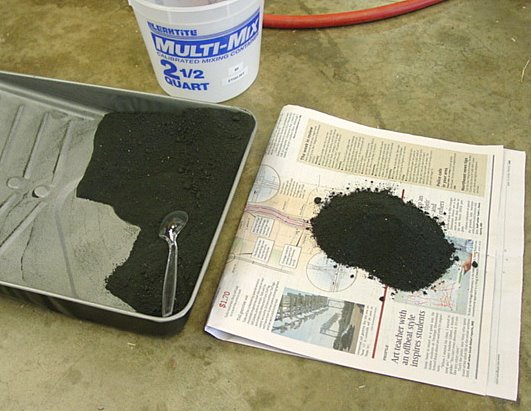
I used a newspaper to transfer the dried BP to a tub. I'll be completely honest... this big pile of BP scared me a bit. i was glad to see it safely in its container.
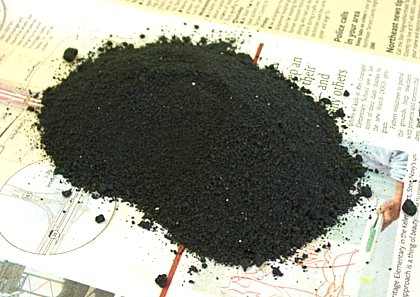
Yield: 437 grams. I probably had closer to 460 grams, as I had already burned some testing.
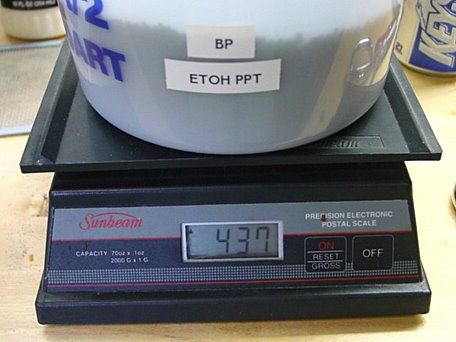
How'd it work? You be the judge! Here's a movie showing the burn rates of green mix, vs. the BP made using this procedure. Please don't laugh at my sandals... it was actually kind of hot today.
The first sample, to the left, is crude green mix as one might make with dry ingredients. The sample to the right is the alcohol ppt sample.
I'd say if you don't have a ball mill, this is probably the best BP you can make. The next process is going to be ball-milled BP, and is supposed to be the gold-standard for homemade BP.
hammermill
Mar. 30 2008
i press mine into pucks and the after it dries crush it and screen it to get the corser granulation then into a ballmill to polish of the rough edges
the first time 50 lbs shows up in a box of 5 ten pound bags i was more then nervious
remenber the alachol is combustable so do this outside to be safe
MADJACK
Mar. 30 2008
Excellent writeup Swede!
I do have one question, I thought plastic was verboten with BP because of the static I suppose. Any input?
Fuzzbean
Mar. 31 2008
I'll have to dig up some of my powder and make a video. I think it was like your "green" stuff, or just slightly better.
I have a golf ball mortar we can pass around as our official test device. Even with commercial powder it only shot about 20 feet -- must be too short or something.
That second batch of powder looks very impressive.
Swede
Mar. 31 2008
Quote (MADJACK @ Mar. 30 2008,23:07)
I thought plastic was verboten with BP because of the static
This is just the sort of info I am looking for, the "do's and don't" of doing this safely. Didn't we have a thread here once (the electronically-ignited BP thread) that showed a small pile of BP utterly ignore a shower of electric sparks?
I'm thinking there are two sorts of sparks. Sparks from a grinding wheel or a flintlock literally throw small pieces of burning metal into the BP and it'll ignite, but electrical sparks? Certainly I'd want to avoid them, regardless.
Hammermill, how did you press your BP into pucks? You are the expert here, anything you can share would be very useful. Thanks!
Postscript to the alcohol precipitation recipe...
After I had slept on it, I realized the amount of liquid I had wrung out of the ball in the t-shirt was really more than 1 tablespoon. I wish I had saved the liquid, because if it was water, it could have carried off significant amounts of KNO3. If it was alcohol, almost no KNO3 would be dissolved in it. So the next time I do this, I'll figure out if it's water, or alcohol.
If it is in fact water, it may be prudent to add a bit more KNO3 at the start, to make up for the inevitable loss when you wring the ball of BP.
Swede
Mar. 31 2008
One more thought - I was visiting a pyro site, and they were talking charcoal. Charcoal is the most important part of the BP, and to get really high-grade BP you need good willow charcoal. Even the stuff the pyro suppliers sell is not willow, but rather mixed hardwoods.
There is a guy that sells real willow charcoal here. For fireworks or casual use, the mixed hardwoods might be OK, but I'm thinking if you want serious BP, willow may be the way to go. I'll order some willow. I'd make it, but there are no willow trees nearby here in TX. If you are going to go to the trouble to make BP, you may as well use the best ingredients if they are available.
Cobbler
Mar. 31 2008
The last few pounds of BP I purchases were Graff & Sons and it came in a plastic container... Wonder if it has something to do with the composition of the plastic, maybe some are more "staticky" than others
.22shooter - second acct for JackfromOz
Mar. 31 2008
Maybe we have a lot more willow here because of the cricket, bats and stumps are traditionally willow wood and often line creeks and water ways here.
I read in a book it had to do with the cellulose content and space of the fibre that was important and in the book the gent theorised about Papyrus as it had both a very high cellulose and space per fibre but he had not tryed it at that stage.
MADJACK
Mar. 31 2008
I have noticed that the powder measures for BP are metal. My GOEX came in a metal can. I'll see if a search on BP safety turns anything up.
here we go
MSDS for BP
Download attachment [ PDF Document ]
Number of downloads: 327
MSDS for potassium nitrate
Download attachment [ PDF Document ]
Number of downloads: 186
general BP safety
Download attachment [ PDF Document ]
post-101-78988-BP_safety.pdf
geodkyt
Mar. 31 2008
"Keep away from static electricity".
You probably have MORE risk from static sparks from the homemade stuff than commercial.
Commercial stuff is EXTREMELY well graded, and is nearly always (always, in my experience) graphite coated. All you need top start the fire chain is for one teeny-tiny particle to catch, which spreads to a slightly larger neighbor, etc -- until it is lighting off the big chunks.
Swede
Mar. 31 2008
Safety is important, and thank you all for excellent tips. One of the books I am reading is "Rocket motor construction" using BP. The author is a highly respected guy, and he claims in 20+ years of loading his own BP rockets, he had never heard of an accidental detonation when only BP is used in ramming up rocket motors with a hydraulic press. When you hear of accidents in fireworks, or this sort of activity, it is almost always from messing with powdered metals, chlorates, and perchlorates. BP is reasonably safe stuff, but exercising care is normal.
I wish I had saved my plastic powder cans that I had used over the years. I'll bet they would have been safe with BP. At a minimum, I need some good, large ammo cans to store the stuff. Because they seal perfectly, they add a layer of safety. Some accidents have happened when some guy is using acetone or other super-flammable liquid, the vapors migrate to an ignition source (like the sparks of a ball mill motor) and the flash of vapor then ignites some big exposed pile of BP. Keeping the stuff sealed and secured is a big plus.
Today, I cut two precious 3/4" bars of brass to create spark-free tumbling media. I am going to execute a straight ball-milling on a very small scale... dry! Wish me luck! We'll see if you can simply dump your ingredients dry into a ball mill, and produce good BP. I'm guessing it's going to come out as dust, so I'll subsequently need to wet it with some dextrin, press it, and then screen it.
hammermill
Mar. 31 2008
static seems to have a hard time igniting black powder
i took a sample outside and used ataser type device to see if i could get it to go
no luck seems a lot of sparks dont have the heat energy
to start ignition
i press my powder using a device like a expresso press with a pressure gauge
i got into this because course powder is hard to come by as is concussion powder in the 6 to 8 f range
graphite coating does slow down ignition
also the powders burn differiently under compression
hence the use of golf ball motors,or devices that lift a weight up thru a set of ratchets to measure preformance.
the ratchet hold the wieght at its highest point of travel for each shot
another thing
DO NOT MIX UP POTASSIUM NITRATE WITH CHLORATE
this is how you can loose fingers
the main reason to ball mill the sulpher is to get the two compounds in intimate contacts with each other
the discussion of charchol leads to some interiesting facts
goex powder is mads from maple charchol
for willow on the east coast use black willow
in the west pacific willow is a good choice
for cotton wood pick narrow leaf it was used during the civil was after willow supplies ran out
oak is said to be used in britan and au land althougt no menyion of species is made
making charchol by the retort method produces the best results expecially if you keep the temperatue on yhe cool side
suggested reading black powder manf isbn 0-929931=21-1
skylighter web site
chemistery of powder and explosives isbn 0913022-00-4
gunpowder by jack kelly adds some interiesting stories
these often show up used at amazon.com
Bubba45
Mar. 31 2008
I wonder how aspen charcoal would work? It's a really soft wood.
hammermill
Mar. 31 2008
my guess is it would do well if retorted right it is related to willow
you would think willow and cottonwood are in abundance in your part of the state
CStol338
Mar. 31 2008
When it comes to storage don't commercial manufacturer displace the oxygen with ether before sealing the can?
Swede
April 01 2008
C, I'm not sure. Are you thinking about smokeless powder? I've noticed that smell too when I open a can of smokeless. Ether + BP would be a scary combo due to the flammability.
The next test is underway! This one is going to be a dry ball-milling with brass media. Ball mills are pretty simple, just a motor drving a shaft through pulley(s) that gives the shaft torque. A non-sparking container rotates and grinds the chemicals into intimate contact, resulting in supposedly some kick-butt powder that will be as fine as flour.
I decided to do a 200 gram batch for my first, using the standard 75:15:10 KNO3, C, S.
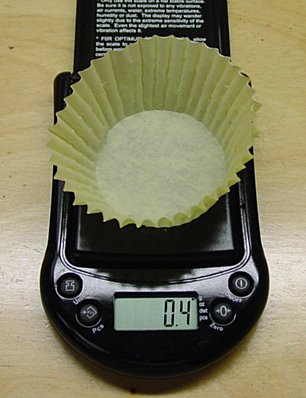
This little scale I got off eBay and is the best 0.1g capable scale I have except for a reloading scale. I think these are marketed to drug dealers based upon the description off of eBay. Anyway, good electronic balances have gotten really cheap. Here's a nice one. I think a good basic pyro balance needs tenths of a gram, and a high end of a kilo or more is nice too.
For this batch, I am going with the primo ingredients. First the KNO3...
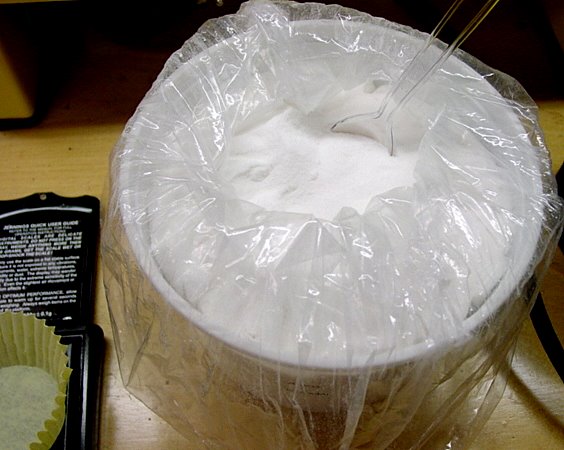

I am using muffin papers or disposable dixie cups as receptacles. Since this little scale doesn't go past 120g, I need to do two weighings, to get 150g of KNO3.
Into the ball mill drum, right on top of the brass media...

This drum is from one of the really cheapo rock tumblers that Harbor Freight sells. I foolishly bought one. The quality is very low. I think if one wants to be serious with this stuff, a much heavier duty ball mill is needed. There's a guy on eBay who sells nice ones. Something like this would be very easy to make, but I have elected to go with the commercial unit to save a bit of time. Here's the guy who sells them...
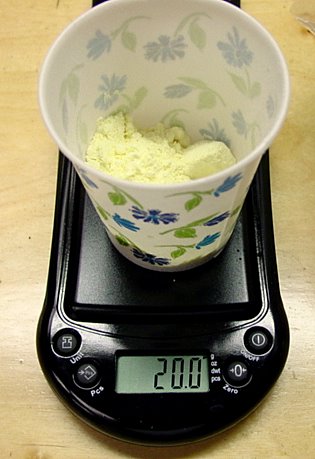
On to the sulfur, 20 grams, which is 10% of 200 grams...
Finally, the charcoal. I have read on various other forums that this charcoal, sold by Skylighter is not the best quality charcoal, but it'll be good enough until I get my willow charcoal. One possibility I'd heard about for what is supposed to be the all-time fastest BP is balsa-wood charcoal. I'll need to try that one of these days!

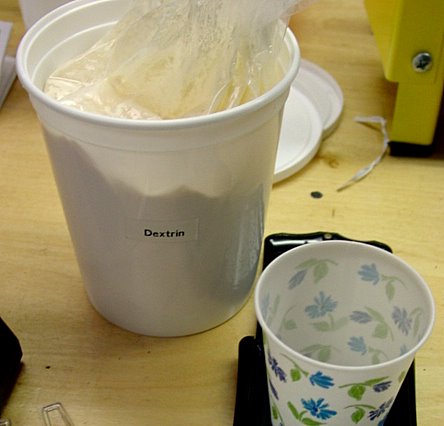
I added 3% dextrin, 6 grams, to the mix. It'll get dispersed right in with the rest of the ingredients, and when the time comes to moisten, it'll activate and be a nice binder.
Mill it wet, or dry? Odd, I've found many different opinions. A lot of people do it dry, without the slightest problem, and I decided to go dry. My reasoning, if the mix is moistened, it is going to clump badly and glue itself to the media, the walls of the jar, and I'll have a bad time separating it. Dry, I'll go through a strainer, right into a clean bucket, moisten and stir, and be ready to screen it.

Here is my bunker. Mosy guys use sand bags or pits. For a 200 gram sample, this will suffice. It is behind my shop, with nothing nearby except woods and the metal shop wall. I used an old steel I-beam as a backstop, then stacked bricks to absorb any blast. It is turned on and off remotely.
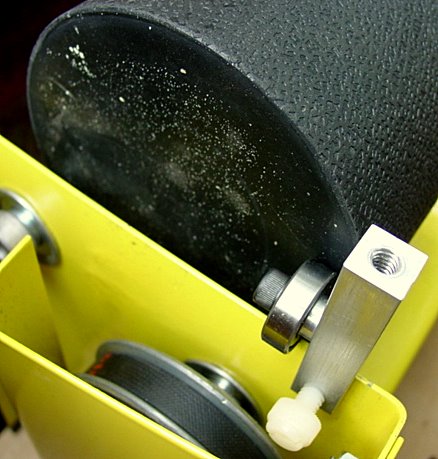
One thing even the good tumblers lack is a bearing for the jar. As these things turn, the jar migrates to one end or the other, and without this little widget I made, would scrape itself to ribbons in short order on the body of the ball mill. I can reposition the bearing to handle any size of jar.

The bunker is sealed, and milling is underway! I am almost half-anticipating a BOOO-OOOOM, but the more I research this stuff, the more confident i am. Even dry, so long as you use a non-sparking setup, I think it's pretty safe.
4 or 5 hours from now, I'll pop the lid and check 'er out!
CStol338
April 01 2008
Swede, I don't know about BP + ether either, that's why I made it a question, cause I never bothered to find out. I thought somebody might have the answer off the top of their head.
buster charlie
April 01 2008
Why not just use dry nitrogen they use for food storage? It would not only displace the oxygen, but displace any water vapor also.
Bismarck
April 01 2008
I have a small video of the powder I made for my muzzle loader, lets see if the link will work.
It was wet ground together with a mortar and pestle.
[IMG]http://img.photobucket.com/albums....MG] Notice the high safety precautions and the fireproof keyboard of my PC.
Swede
April 01 2008
Bismarck, that powder looks quick! I think you got some good charcoal. It's interesting, I see small burning flecks glowing red then fading out long after the bulk of the powder has gone WHOOSH, almost as if some of the charcoal pieces didn't quite get integrated completely. I bet it shoots well.
The very first BP I ever made was when I was a kid. I swiped some KNO3 and sulfur from the school science lab, but the only charcoal I could find was some thick artists charcoal pencils. I used those, made a batch ground wet, maybe 4 ounces, and that powder worked great in my 1851 Navy. I think once again we see good charcoal = good BP.
Latest test: initial results, 4 hours of ball milling... very encouraging! Pics to follow.
hammermill
April 01 2008
the smell i think is the acetone from the nitrocellose compound at least to my nose
come on swede you can have up to 50 lbs is it
gona take a while at 200 grams each
did i mention i am staying in bunker 47 of fuzzybeans unfinished projects until your finished
Swede
April 01 2008
Here's what I saw when I lifted the lid after 4 hours of balll-milling:

Looks good - completely mixed and in a grain size like corn starch.
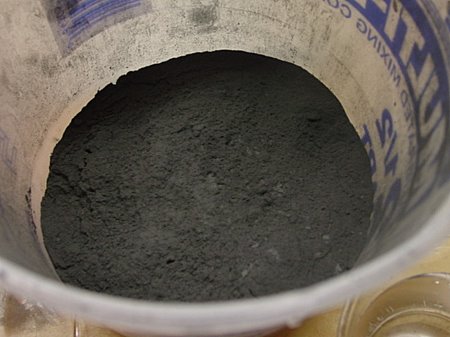

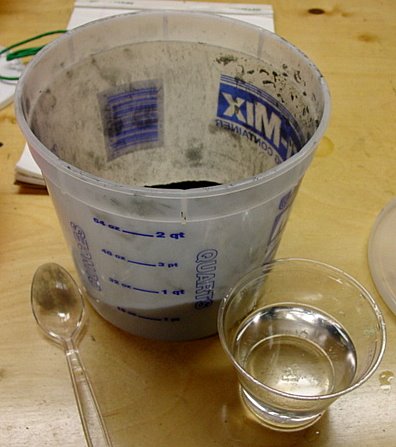
I prepared a cup of 1/2 water and 1/2 alcohol to make a BP dough. Wearing vinyl gloves, I added the liquid to the BP, stirring, and just like flour would, it formed a dough ball.

The good part is, it is tacky, so it automatically gathers itself up with a bit of manipulation. All that was left in the bucket was a few particles.
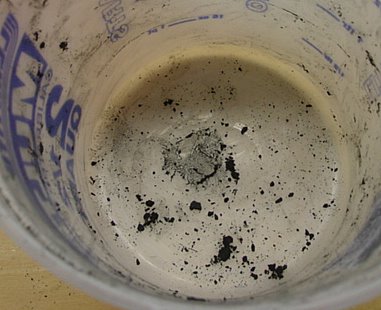
I did add dextrin to this. Dextrin is a form of glue or binder, and that certainly helps. If allowed to dry in this shape, it'd harden up and be a real pain to work with later, so right away I went for the screen. This is a piece of aluminum window screen I glued into a frame that was specifically sized to fit over this teflon paint pan. The paint pan is ideal. Nothing sticks to the teflon... it is cheap, and also forms a perfect tray to dry the BP in.

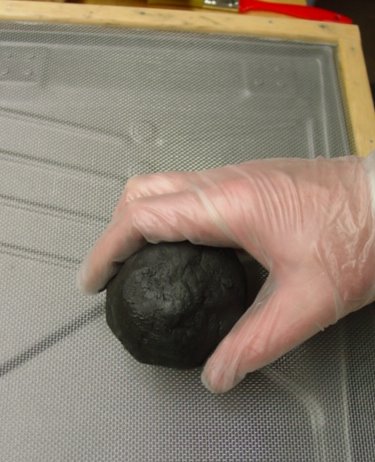
While the BP dough is soft, it screens really easily. The whole ball went through the screen in about 2 minutes. It formed some nice grains. This time, I decided to not touch the powder in the paint pan until most of the drying is done. I think this helps maintain the grains in their current size and shape, and not collapse into dust or smaller pieces.
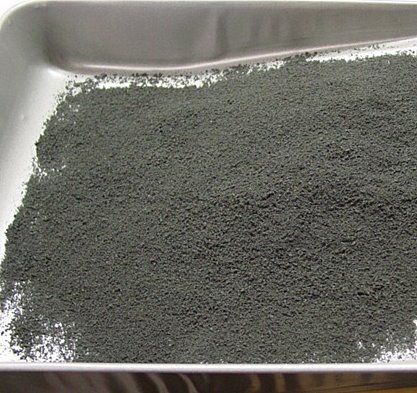
A small sample of the end result...

Nice grains, a bit fine, but no problems. The big question, how does it burn? Initial tests show an excellent powder that I think is just one step away from commercial. It is really good powder that would perform perfectly in any smokepole.
I decided to press a few nuggets in a hydraulic press.

Pressing and then rescreening is supposed to produce even better BP. I'll take some videos tomorrow, but a simple side by side comparison between this powder, and the stuff from the previous alcohol batch, this stuff is MUCH faster! Hurrah!
The next step will be willow charcoal, and after a bit more research, a very small batch made with Potassium perchlorate, which is even zippier, unless someone can talk me out of it.
Oh yes, Hammermill, 200 grams was more than enough for a first milling! The jars that came with the ball mill are HUGE. I'm guessing they could produce 4 or 5 lb of primo BP at a time.
Summary - if you want really easy, excellent BP, buy or make a ball mill. It couldn't be easier. You toss the ingredients in the jar, turn it on, and it makes BP, simple as that.
coyote65
April 01 2008
You can probably use a flour sifter to recover your media.
hammermill
April 01 2008
if you are thinking of messing with potassium perclorate
i am going to start filling sand bags for the front of the bunker
chlorates are not for gun powder
do not do it
if mixed as blacpowder it is used as salutes, and maroons and in concussion motors for a sharp salaute
i have seen 5 inch steel concussion motors split with these mixes.
as a final thought remenber to be very carefull
lest your friends comfort your widow
all of that said mpotassium burned under no confinement burns cool enough to produce vividly dyed smoke
skylighters green is wonderfully hideous
on storage the aluminum budweiser bottle is a nice storage container
sand i need more sand
Mrtank
April 02 2008
I personally am not a fan or Potassium chlorate, or Potassium perchlorate in any way shape of form. It is making a dangerous thing even more dangerous and sensitive. I wouldn't want to see you hurt. I strongly recommend agents it.
On a lighter note I was thinking, you could set up a screen to rotate at a set speed and press your nuggets in at a fixed rate. That way you could control the grain size, and keep it even for all of your black powder. Just some of my random thoughts. With the way this thread is making me think I may have to the buy/ do list...
Fuzzbean
April 02 2008
Man, that's some nice looking powder you are making there, Swede
.
When you finish all your research here I hope you condense your optimum
findings down into a simple recipe with specific ingredients, amounts and
times, so I don't have to use my brain anymore.
About the ether smell from smokeless, that is actually ether or something close to it, that they use as a solvent in the manufacturing process. Raw nitrocellulose looks about like the cellulose fibers it is made from, but unlike cellulose is soluble in ether. So it's dissolved in ether (or ether plus nitroglycerine for double-based) to make a dough-like stuff they squirt into noodles and chop into grains or flakes for the traditional process. Nitrocellulose was an early forerunner of all the polymers we have today, and was actually molded into things like combs and hand mirrors before they had better plastics. Photographic film was made from nitrocellulose for many years; I've read that movie film was sometimes chopped up and used for gunpowder over in Afghanistan or someplace.
You know how smokeless powder is often in the form of little tubes? Maybe a lot of people know this stuff already, but that is because the powder only burns on the surface and they want to keep a constant surface area as it burns. Ideally the surface area should actually increase, so the powder could keep up its burning rate as the bullet accelerates faster and faster down the bore. That would make a truly "progressive" burning powder, and a flat pressure curve. But that isn't possible, so the best they can do is form them tubes so the inner surface area burns bigger as the outer surface area burns smaller, and things compensate out partially.
Now ball powder is another story. The process offers big manufacturing advantages, but the powder must come out more or less in a ball shape. It's a process involving liquids that are not miscible, so the powder grains are formed ball shaped for the same reasons that oil droplets in water tend to form into balls. But a perfect ball is the very very worst shape a powder grain could possibly be. Its surface area must decrease rapidly as it burns, making a very undesirable degressive burning rate. So to compensate they coat or soak the grains in a chemical that inhibits burning. That way the outside has the most of that chemical, and the big area available at the start burns slowly. As the outer layers burn away, less and less of that chemical has penetrated inwards, so the grain burns faster and faster to compensate for its smaller and smaller surface area. This works out very well, except that the outer surface has so much of that chemical on it that it can be hard to get the powder to ignite in the first place. Which is why magnum primers are often needed with ball powders.
I'd stay away from chlorates or perchlorates for making powder. One thing, aren't those super dangerous when mixed with sulfur? Even without the sulfur, they are bad news. When I was a kid I discovered some common stuff you could buy from Sears that was made of sodium chlorate. We used to make gunpowder by mixing it 50/50 with sugar. One time my friend was ramming a bullet down the sticky bore of my home-made gun (a section of rusty Springfield 03-A3 barrel I plugged with a bolt) and the stuff went off. It tore his wrist open for about 4 inches, and made our fiberglass fishing pole ramrod look like a piece of rope. We had intentionally set the stuff off by hitting it with a hammer many times before, and should have known that would happen sooner or later.
Swede
April 02 2008
Hammermill, Mr. Tank, and Fuzzbean, thank you. I will not mess with the perchlorate in any fashion until I am ABSOLUTELY sure whatever recipe calls for it, is safe and proven.
Chlorates: Maybe after 5 years of extensive practical experience. For now, it will not even be in my shed.
Fuzzbean, that's some cool information on the smokeless powders, especially the ball powder. In college chemistry, we nitrated a LOT of paper and cotton. Heck, we'd nitrate just about anything in small quantity to see what we could get out of it. The problem with smokeless powder, gun cotton, etc (for stupid kids like us) is that it wouldn't go "bang" unless it was confined. I still made some nice salutes by packing nitrocotton into a 35mm film canister, and wrapping it up in a lb of duct tape.
With the goal being a true high explosive, we tried desperately to make TNT. Our best effort yielded a waxy yellow solid. When we saw that, we thought we had succeeded, but analysis of the solid showed that it was DNT, di-nitro toluene, and not TNT. We also learned that it is very toxic. We disposed of it as a hazardous waste. Never did get caught. And we're lucky to have passed through that idiocy unscathed.
That stuff was all long ago, in my very, very stupid era, and I have no strong desire to do it anymore - thank goodness.
I'll do another little video, comparing this ball-milled powder, to the alcohol powder. I think the speed of the burn compares much like my first video, where it was greenmix vs. alcohol. The alcohol prepitated BP, while not as fast as the ball-milled, really is good powder that I would not hesitate to shoot.
hammermill
April 02 2008
we frequently disolve nitrocellose in acetone to make a coating for fuse and other compounds.
nitro cellose movie film would burn really good hence the old projector rooms had asbestous walls lined with metal and all openings had fuse links holding them open.
also considering that light came from a carbon arc rod being the projectionest must of been hair raising to say the least.
Bubba45
April 02 2008
I read in an Nat'l Geographic that the Afghan Rebels used old movie film for propellant in loading 303 Brit shells while fighting the Ruskies . They experimented with cutting size for regulating burn rate.
jkilroy
April 02 2008
I used to do a lot of this pyro stuff when I was a kid. (13 or so) I was lucky enough to have a friend who had parents that encouraged this type of hobby. Imagine today a parent buying black powder and fuse so a child could make home made fireworks in the garage? Probably be on some federal list or behind bars.
However, where does one find one of these ball mills? Is it like those old setups for polishing rocks except with different media?
big art
April 02 2008
Swede that was a good bit info on home made BP. when you posted the link for skylighters it rekindled an urge to try making my own BP. I didn't buy their book at this time in part because I have come across some ideas or recipes that you have not mentioned in your writings. I am making my ball mill using 6" pvc pipe for the tumbling jugs and constructing a water wheel to power it, I have a small creek with sufficient flow to do the job. In my research I discovered the sulfer is used to lower the ignition temperature by about 100 degrees C. A very good BP could be made comparable to Goex BP without using sulfur at all but you do need to add more charcoal. This mix is said to work well for cap & ball guns but causes misfires in flintlock guns, I am guessing that is based on using the sulfurless mix in the flash pan. If it were possible to use a charcoal and saltpeter BP to propell the bullet and use a charcoal,saltpeter, and sulfur BP in the flash pan one could save money by eliminating the sulfer for most if not all of your BP needs based on whether or not you use flintlock guns. Eliminating the sulfur also reduces the white smoke and sulfur smell, you still get the fouling. I also plan on testing my BP by shooting thru a croney and comparing penetration with comercial BP. On making charcoal it is better to use branches less than 5cm dia. with the bark removed and if having trouble locating good woods pine can be used its not as good as the previously mentioned soft woods but still better than hard wood charcoal. My goal is to buy as few chemicals as possible and still have a BP that is comparable to comercial grade BP. Good luck on your quest for a good homemade BP. Art
hammermill
April 02 2008
if you go to skylighter look at the newsleter section
if on the west coast firefox enterprises is another although some what hindered source
Swede
April 03 2008
Art, that is some very interesting info, indeed! I think I will prepare about 4 different green mixes, starting 65:35 KNO3:Charcoal, and maybe 60:40, 55:45, etc, and compare the burn rates in an unscientific manner. If we can narrow down the ratio, I'll bal mill it and get a good batch. Unfortunately the ratio will vary with the type of charcoal. The stuff I am using is "mixed hardwoods" and not the best.
I like your concept of a self-sustaining, water-wheeled BP mechanism. I've made charcoal in the past... I do know how to do it, but I've kind of reached a point where I have so much going on, I've decided to just buy the stuff. I look forward to the willow arriving. But I do believe it is important to know how to make charcoal. Maybe one of our Aussie friends will go into a bit of detail for this thread. I am hoping, when it is finished, it will be a sort of treatise on various means of making BP, which of course is a true emergency propellant, and all-around useful stuff!
Swede
April 03 2008
I do agree with that, and the sulfurous smell is part of the charm, too.
Part of me though is thinking homemade BP could be critical in the future if Washington sleazebags attempt to really hurt us in a legal way; no more smokeless powder, each round of ammo has a $5 tax, or simply elimination of the 2nd amendment. If we could come up with a safe, easy, and effective way to reload, let's document it. Maybe a less smoky BP could have "tactical" uses.
Letting my imagination run amok, let's say we are reduced to nothing except what we can make in our homes. I know there are ways to make primers, but that can be iffy. We can always make a matchlock or flintlock. I'm picturing two powders, a sulfurous variety for the pan of the flintlock, and a speedier, less smoky powder for the ball.
I've heard that some of the BP substitutes have added ingredients just so they'll smoke, and that in their native state, are smokeless. I'd love to get the recipes for some of them, but I'm guessing they are just highly modified nitro-based powders with burn modifiers added.
Swede
April 03 2008
Man I'm going nuts with this stuff.
ALL red-blooded, REAL MEN MUST look at this site.
"Pyroguide.com" it looks like I'll be busy for a while.
Here's a great article on making super-fast Balsa Wood Charcoal on a home BBQ grill.
brokengun
April 03 2008
Swede, before you go nuts, and since you raised the very serious question about future prohibitions on re-loading and potential ammo taxes, have you ever thought of making your own smokeless powder?
I have never done this, seen it done or used it but i have read that a 30 caliber rifle powder can be made using potassium nitrate, granulated white sugar with a little iron oxide thrown in to control burn rate.
Supposedly it creates a fairly fast rifle powder and I'm just guessing that it would be similar to IMR4227.
If I remember right it's a flake type powder and it you must use the proper sized screen to make it or the burn rate will be off.
geodkyt
April 03 2008
If I need to use a home made BP powder mix "tactically", I'm making a Howda pistol (probably with an electrical ignition), loaded with shot. It will be used on a relatively unsuspecting and definately solitary target who has a better weapon, and rammed into his torso before firing. The smoke from ignition won't be an issue.
Frankly, the chances that I'd ever need to do it are so slight as to be incalcuable -- there's WAY too many armed individualists in this country for us to be held down by opporessive force any time soon that takes control quickly and strongly enough that there's no opportunity for a realistic rebellion with current ordnance to spontaneously erupt. (Cool, huh? Having the ABILITY to rebel makes it less likely that it will be necessary to rebel. A somewhat self regulating system... maybe those old dead white guys weren't so dumb, after all. )
So, for me, BP is all about the nostalgic recreation of the historical mythos this nation was founded on. I'll leave the tactical employment to my ancestors. For my purposes, I want it all -- smell, smoke, BOOM!
coyote65
April 03 2008
Swede, are you going to run the various products thru a Chrono? I would be interested in what the difference is between "Good" and not so good BP. Years ago I read an article in a BP mag that was dispelling BP old wives tales. They had a test barrel with a pressure guage and a chrono to determine FPS. The big conclusion I remember out of the article was that BP is a really slow burning powder compared to smokeless. I am wondering if you can improve the speed of BP by just pulling it out of your mill while it is in the talcum powder consistency and using it for a substitute for smokeless?
kanton
April 03 2008
Swede's "thinking homemade BP could be critical in the future if Washington sleazebags attempt to really hurt us in a legal way" is true today. A local gun dealer told me he doesn't carry BP because a $250 annual license makes it unprofitable.
A good book is "The-Do-It Yourself Gunpowder Cookbook" by Don Mclean. In Chapter 7 he discusses a mixture of saltpeter, sugar and rust.
.22shooter - second acct for JackfromOz
April 03 2008
For Kanton YES!!! a wonderfull book but a little lacking in preperation tips but the recipies all work well.
Swede, Jack read your post last night and had his friend Blue Dragon from the muzzle loaders send me this a short while ago.
jack and warrens Charcoal cookery
They are preparing the summer charcoal cook for next 2 weeks and will document the Direct method of making charcoal. Maybe indirect as well depending on avaiablity, cash and costs.
Jack wrote a shorter version for the Adelaide University Regiments Rifle and Pistol Club and the "Mountain Men" BP club many years ago and stated he needed to update it and also make it for everyone not just bush folks who speak 'Strine, and so he has grabbed Blue Dragon ( warren) to edit the work.
Warren used to write for the popular magazines here back when and is a regular on many BP and ML forums.
Part 1 is the science of charcoal, what wood makes good charcoal, how to prep willow for coaling and a basic build for a coaling kiln from scratch. ( uploaded now, see link)
Part 2 will be pics of the process and a description of process's and what to watch for and how to recognise the signs of coaling or burning ( burning is bad)
Part 3 will be experiments with stale or old BP and differing charcoals to show the results and if they can get enough papyrus they'll do a nitro- cellulose mix if practicable.
Jack only has 2 weeks in South Australia and apologuises if its a bit rushed but he has to return for his VA doctors appointments and cant afford to miss them.
Swede
April 04 2008
Quote (.22shooter @ April 03 2008,22:03)
Jack and Warren's Charcoal Cookery
This is an OUTSTANDING document, thank you! Would you mind if I distributed it to others interested in BP? Thank you for your thoughts.
Coyote, I have no current plans to test the BP beyond the crude "looks fast" small burning piles. I've got plenty of Goex, and at least I can compare it to that. Oddly enough, there are many fireworks types who claim to have done better BP than Goex, and I don't doubt this because Goex does in fact use mixed hardwood charcoal due to cost and consistency.
brokengun and Kanton, I think exploring propellants other than BP is an excellent idea. I do have the ingredients for the KNO3, Iron Oxide, and sugar recipe, and I'll see if I can come up with an easy method. My problem: I will not put anything except BP into a frontstuffer because of the potential danger, and I'm a bit leery about loading unknown stuff in my cartridge rifles. I wish I had a beater gun that I could mess with. I'll see if I can't come up with some way to test. We know that modern smokeless powders burn slowly unconfined, and they will only work propely in a firearm, meaning if we simply make a little pile of powder and light it, it doesn't tell us much about its potential.
royce
April 04 2008
As a side issue, many of us (meaning probably just me) have never touched black powder or fired a BP firearm.
What does all of this BP manufacture mean to me if I don't have a BP firearm?
Can I use BP in a regular cartridge firearm?
A bolt rifle or my modern Peacemaker?
MikeB
April 04 2008
I've shot pyrodex (newfangled BP substitute)in my 44mag...
worked good I'll guess about 45acp performance. I put together a Dixie Gunworks kit .54cal "Hawkins Style" rifle and I shoot it with Goex... and it is great fun to shoot, even if the other guys on the firing line have to wait for the smoke to clear to see thier targets. I also shoot BP in my little cannon ( at least I used to. Last 4th of July I fired it a couple of times and it attracted the police helecopter and a couple of squad cars... So I won't be fireing that in town anymore.)
The other good thing about BP is it's low pressure. So it is perfect for simple "homemade guns". It don't get much simpler than a match lock and many locks are available for building flint and percussion guns.
The one real downside to BP is it is often hard to get ( can't be shipped, stringent storage rules, and fees...
geodkyt
April 04 2008
BP is best used in manually operated arms, as it is quite dirty. Remember that all of the manual operating systems were first successfully done with black powder. Your right arm (for instance) is more capable of applying additional force to deal with powder fouling than a gas or recoil system.
Semiautomatic and full automatics generally waited until "smokeless" power was available (although there were examples done with BP). The Gatling gun and other "manual machineguns" bridge the gap, and were successfully employed with BP.
CStol338
April 04 2008
Quote (royce @ April 04 2008,11:13)
Can I use BP in a regular cartridge firearm?
I agree with geodkyt, it can be used in just about any firearm but it isn't reccomended.
Some good examples of BP cartridges are still around today though. Like the 30-30 winchester 30 caliber - 30gr BP or 45-70 45 caliber 70gr BP or one of my personal favorites that I still load BP is my 32-40 WCF 32 caliber - 40gr BP and there are lots more out there.
A couple of good books on reloading BP are "SPG Lubricants BP Cartridge Reloading Primer" 4th edition revised, and "Loading the Black Powder Rifle Catridge" by Paul Matthews.
Swede
April 04 2008
From kit or scratch pick a period and go for it.
Very tempting! I've got a flintlock pistol that I'd call a kit but it's pretty rough, plenty of work left to do. It's been boxed for a while, awaiting just the right moment.
Generally, bigger is better when dealing with BP. Just about any rifle caliber 40 or larger will probably do OK with BP, and in some cases do more than OK, like the big old Sharps buffler guns. I've got two .45-70 Sharps, one a C. Sharps Arms M1875, the other an Italian knockoff of the classic 1874. I've got the brass, the dies, the bullets. All I need now is a chronograph to really experiment with this stuff.
I tried a .30 M1 carbine cartridge PACKED with 4F. it fired fine, but did not cycle.
Interestingly, the early Maxim machine guns were designed for BP cartridges, and worked well - a testament to Maxim's genius. He took the fouling into account, and that made the gun even more effective when the smokeless cartridges came into being. Those African Natives learned a harsh lesson - do not mess with the Maxim.
In an emergency, you could probably easily kill game with any .30 caliber rifle + BP. If your gun is a semi-auto, you may be required to cycle it for each shot. And be sure to clean like crazy, with an aqueous cleaner, for Mr. BP is very corrosive.
Swede
April 04 2008
Oh yes, today I milled a 70:30 KNO3:Charcoal mix. No sulfur. I will test it now and see how it works... hang tight a moment.
brokengun
April 04 2008
Homegunsmith Funny...
While doing some research into sinus conditions and treatments I discovered
that Swede
may be practicing medicine here instead of making BP.
I've just learned that gun powder was used in early homeopathic medicine!
The way I understand it a special grade gun powder was mixed into the formulas.
Talk about blowing your nose.
http://www.sinuswars.com/Ingredients/Ingredients-SinusWars4.asp
nevadablue
April 04 2008
swede, you should make a test action, just a simple block chambered for, say 45-70 or something like that. I think there is a thread somewhere here showing a test device. I'll do some looking.
Bubba45
April 04 2008
MikeB, an update, BP can be shipped. www.powderinc.com ships all over the U.S. Good prices too. Get it while you can.
hammermill
April 04 2008
if your going to get some order as much as you can to save on the haz-mat fee but watch the 50 lb figure
MikeB
April 04 2008
Thanks Bubba and Hammermill... I get it from that last surviving gun shop in my neck of the woods and pay about $20/ lb.
Not that much more than powderinc. I've been told that I'm not allowed to store more than 5 lbs here in the peoples republic. That maybe without a n approved storage locker. Don't quote me on that I haven't seen the law myself.
But I'm saving me willow branchs and watching while Swede demonstrates the Black Arts.
Swede
April 04 2008
Sorry about the "just a moment..." It turned into several hours.
A small pile of sulfur-free BP, milled for 5 hours, and as fine as talc, burned very well. It was much faster than the first green standard powder in the video, but not as fast as my best milled powder. It did smoke, exactly the same as normal BP.
But something was missing... the smell! The smoke had a weird, clean, "chemically" smell, totally unlike regular BP. It was odd!
Some thoughts - The charcoal I used for this test was junk hardwood, milled from a bag of BBQ charcoal from Home depot. The proportions - totally made them up. I can see that with a better charcoal like willow, in the optimum proportion, it would work, and probably very well.
This experiment I think shows that sulfur-free BP is feasible, and might be a player if one has no sulfur. But unless we can figure out that there is some advantage we don't recognize yet, I can't see making it unless you have no sulfur.
The three components in BP have been around for hundreds of years. There's nothing new under the sun with BP, and I'm pretty confident that nations who defended themselves with BP weapons would have skipped the sulfur if, in doing so, there was no loss of performance.
But all in all it was pretty cool and I think it's worth doing again when I get some decent charcoal. And those of you waiting for seismic indications - so sorry! You'll have to put up with my blatherings a while yet. Time for some quality sleep... Good night!
buster charlie
April 04 2008
So if one wanted to mess around with this, would one of the cheap harbor freight rock tumblers and some lead sinkers from a sporting good store be a good start on the cheap? Any other sugestions for easy to find grinding media?
buster charlie
April 05 2008
For the tumblers, they offer them in 3 pound and 2X 3 pound setups. how many
.50 cal lead balls would you think would be sufficent for a 3 pound tub? Also
the 2X setup is only a few dollars more, but part of me thinks the single tub
is a safer setup in case something went wrong.
Swede
April 05 2008
Buster, I bought that exact rock tumbler from HF (the 2-jar version) before I bought the larger ball mill. The quality isn't the best, but it does work, the jars are actually pretty decent, and you don't have to load two jars on it, you can load just one.
One of those little black jars requires maybe 400 .50 cal balls... it's a bunch more than you might think. I've milled with both lead balls and with brass slugs, and I'll be honest, I like the brass slugs MUCH better. For some reason the lead balls really hang on to the mix. I ended up working much harder separating the meal powder from the balls, than I did from the brass slugs.
If you want to try the balls, you can cast your own, or you can buy them from Dixie gun works. DGW had by far the cheapest price at $9 per 100. At Cabela's they were $15 or so. If you want to do brass slugs, a length of 3/4" diameter rod is cut via bandsaw (or hacksaw, if you have the energy) into 3/4" lengths.
I deburred mine by tumbling them with some of the abrasive grit that came with the rock tumbler.
Jars - DO NOT BUY JARS! You can make them perfectly out of PVC pipe. The classic PVC jar is a length of pipe, capped one end, and the other end, you use a transition, say 3" to 2". On the 2" end, you make use of one of those rubber caps with a hose clamp. Another option, buy a pair of test/blowout plugs that fit INSIDE the pipe. The problem with those is there is a tiny bit of metal that is exposed to the mix. We must cover that. Here's how...
Swede
April 05 2008
PVC pipe test plugs fit internally into a section of pipe, and by turning a wing nut, a rubber biscuit is expanded, sealing the pipe perfectly. There are several brands... look for the "Oatey" brand, as I think it is much nicer than the others. In the U.S. Lowe's carries them.
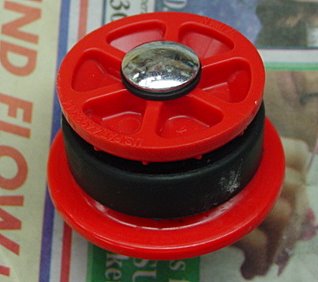
They consist of two plastic disks, a deformable and thick rubber ring, and a 5/16" carriage bolt. The head of the bolt is the metal we are concerned with. Beneath the head is a rubber washer. Remove that.
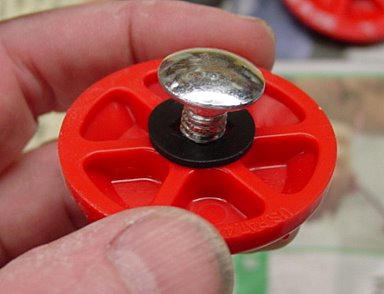
We are going to use epoxy putty to fill in the plastic cap and cover the bolt. Those who have worked with the epoxy putty in a stick know that it is some pretty amazing stuff and should easily withstand the abuse of a ball mill.
Epoxy on plastic is more of a mechanical bond than anything, so it is best to at least roughen the plastic. I used a dremel tool to create some undercuts and generally roughen the plastic...
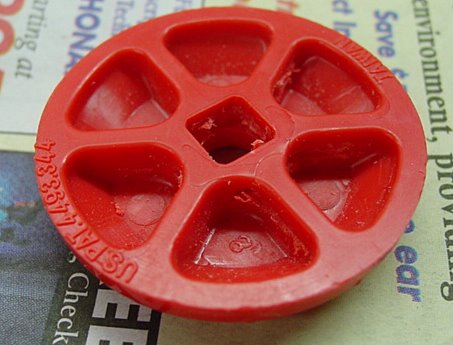
This is the brand I used. Lay your stuff out and be ready to roll, because it sets in about 10 minutes, no more.

Mix the epoxy putty. Roll a bead like play-dough and place it below the head, like so:
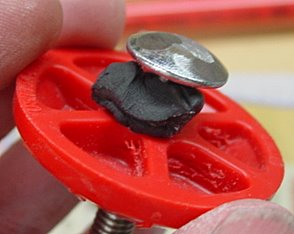
Then, tighten the screw down pretty hard with the supplied wing nut.
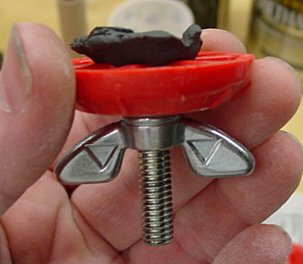
Build up the rest of the encap into a mound of smooth epoxy. I recommend using vinyl or butyl gloves. I actually chucked the bolt in my lathe and on a very slow speed, used the palm of my hand and fingers to give it a nice shape. You can use dabs of water; that will help smooth it out. This is what it looked like:

It will get quite warm. After it sets, reassemble the plug. Your plug is now ready to do some serious ball milling! To use these, you cut a length of pipe, perhaps 6 to 12", insert the plug into one end, add your media and chemicals, and install the second plug, sealing the jar. These are 2" plugs, which I bought for milling small test batches. For real production, go 3" and preferably 4". Have fun, be safe!
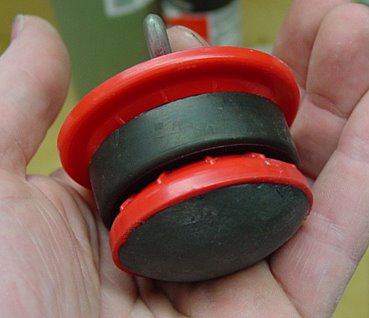
I'm off on a 2-day trip, guys, got to make $$ to eat and buy toys. In the meantime, let's think of alternate firearm cartridge propellants along with the BP. I'll get some video up, too, of the new ball-milled batch, which is good stuff.
I've been looking at KNO3 + sugar - based fuels, and they do look promising. I think the trick is going to be in the corning / graining. Maybe some extrusion dies and a hydraulic press? We'll see!
http://www.chuckhawks.com/difference_black_powders.htm
Added: Excellent read on BP substitutes.
Note the use of "Sugars" as the fuel source! This could be it! If we could avoid Nitric acid (used to create real smokeless powders) and get a decent propellant, we'll be set!
big art
April 05 2008
Swede, in rechecking my research an 80 to 20 mix might get you closer to optimum performance in a sulferless BP.... BP had pretty much reached its peak as far as power by the mid 18th century. About 1875 the Swiss, because they were unable to see their attacking enemys after firing large volleys while defending their their castles started to develope a smokeless BP. With the advent of smokelss powder in the late 1800's the BP guns and canons were soon obsolete on the battle fields. That is the reason smokeless BP never gained widely accepted use. I am sure Swiss would have done their best to keep this developement a secret for as long as they could.... I see you are going in another direction with your experiments so I don't expect you try this mix.
Fuzzbean
April 05 2008
I don't know about using lead balls in the milling process for black powder. Seems like some lead would be ground into the mix and then when you take deep breaths of the smoke and hold them you'd be getting lead in your lungs.
Anybody know anything about making powder from vitamin C? Some school teacher I met at a gun show years ago told me this, and I thought maybe he was pulling my leg. More recently I read that some of the commercial substitutes are made from vitamin C. I can't remember what you mix it with, maybe saltpeter. It sounds pretty simple, if you got lots of pure vitamin C available.
There was also something called "Golden Powder" that I got info on from a gun show or NRA convention back in the 1980's. They said it was non-corrosive, safe to ship, edible, moldable into caseless ammo, etc. etc. but then I never heard another word about it. I thought it might have been an investment scam of some sort, as they seemed to be looking for financial backing more than for customers. Or maybe that was the vitamin C too.
kanton
April 06 2008
According to Wikipedia at http://en.wikipedia.org/wiki/Gunpowder
"A simple, commonly cited, chemical equation for the combustion of black powder is
2 KNO3 + S + 3 C > K2S + N2 + 3 CO2.
A more accurate, but still simplified, equation is[6]
10 KNO3 + 3 S + 8 C > 2 K2CO3 + 3 K2SO4 + 6 CO2 + 5 N2.
The products of burning do not follow any simple equation. One study's results showed that it produced (in order of descending quantities): 55.91% solid products: potassium carbonate, potassium sulfate, potassium sulfide, sulfur, potassium nitrate, potassium thiocyanate, carbon, ammonium carbonate. 42.98% gaseous products: carbon dioxide, nitrogen, carbon monoxide, hydrogen sulfide, hydrogen, methane, 1.11% water."
Thus taking deep breaths of the smoke, even if it were produced without lead is not a good idea! I would worry more about lead poisoning if I were standing in front of the barrel!
Spartiate
April 06 2008
Quote (.22shooter @ April 06 2008,03:43)
acetic acid anydrous (sp?) is a big no no in the US i found out just
today
By way of clarification, just in case you do find a way to navigate the legal hurdles and decide to google a supplier:
Vitamin C is either ascorbic or citric acid (not sure which makes good gunpowder). Acetic is vinegar. Acetylsalicylic is aspirin.
Machine_smith
April 06 2008
Here you go, I found these awhile back but my studies stopped short of throwing something into the ball mill. Maybe It'll help you guys and I'd love to see a homemade replica powder.
US patent "H72" Organic substitutes for charcoal in black powder
http://patft.uspto.gov/netacgi....N%2FH72
US patent "4,497,676" Gunpowder substituted composition and method
http://patft.uspto.gov/netacgi....4497676
US patent "4,128,443" Deflagrating propellant compositions
http://patft.uspto.gov/netacgi....4128443
Swede
April 06 2008
Acetic anhydride is unfortunately used to turn Morphine into Heroin, and is one of dozens of chemicals, some of them common, that is on a DEA watch list. Buyers of these chemicals are scrutinized closely.
Machine_Smith, thanks for those patents. One of the lines jumped out at me...
"3. A composition according to claim 1, wherein the oxidizing agent is potassium perchlorate and the organic carboxylic acid derivative is sodium benzoate."
Hmm, I just happen to have both of those on hand!
I'm hoping for simplicity sake that our answer for a nice, simple, and safe PROPELLANT will be some intimate mix or melt of KNO3, a sugar, sucrose, dextrose, or fructose, and perhaps one or two additional "secret" ingredients. Melted, extruded hydraulically through a bank of small holes, and cut with a blade so as to create consistent grains.
Totally off topic, I launched my first simple homemade firework today using the alcohol precipitated BP. Worked like a charm!
Fuzzbean
April 07 2008
Vitamin C is ascorbic acid. It has little if any use related to illegal drugs that I know of.
I think making powder from vitamin C sounds interesting, if it can be got cheap. The pills from Wal-Mart probably contain too much filler stuff, but maybe the pure vitamin could be extracted in a really desperate situation.
I'm skeptical that gunpowder made from sugar will work without gumming up your barrel something awful, though maybe a balanced mixture might burn more completely than the chlorate powder of my childhood.
Swede
April 07 2008
Guys, it is a simple fact that the production of BP or other propellants blurs with the production of explosives. I don't see how we can experiment with propellants and not deal with chemicals that may be a component of an explosive, or by pure, random chance, a drug precursor. Yesterday in a garden store, they had out perhaps 6 ea. 5lb baggies of KNO3, looking very pure, the consistency of sugar, priced at $6.00 each. I asked if they had any larger bags. When they said "no" I bought all they had, and nobody blinked an eye. I refuse to feel guilty about buying what is a completely legal product, just as I wouldn't feel guilty about buying a firearm, or a box of sudafed tablets.
I appreciate all the offers of help to set up some sort of a test rig. My 1875 Sharps (a very strong falling block) is too nice to risk; the 1874 Sharps too weak. How about a Contender pistol? And if so, in what caliber? How strong is this pistol? I'm thinking a .357 magnum barrel, and start with .38 special brass, "test powder" and a chronograph.
We delve into a potentially very dangerous realm with alternate propellants. How pressures peak, the speed of the burn, weight of the projectile, all add into it.
I think the goal should be a BP substitute that behaves like BP, is easy to make, and delivers reliable perfomance rather than extreme pressures and velocities.
Swede
April 07 2008
Look at this one:
A composition comprising 70 parts of potassium perchlorate, 30 parts of sodium benzoate and the following percentages of water gave ballistic results as indicated in the following table:
% H2O Peak Pressure Muzzle Velocity
2% 25,000 1650
5% 18,000 1700
10% 10,000 1577
15% 7,000 1310
25% 2,500 1231
All loadings were in a 0.222 commercial cartridge with a 53 grain bullet. At 25% water, the mixture is a slurry.
"In a similar manner, the compositions prepared by blending 75 parts of potassium nitrate, 15 parts of sodium benzoate, 10 parts of sulfur and 3 parts of water had an excellent velocity-pressure ratio."
hammermill
April 07 2008
if it burns anything like a kno3 and sugar smoke pot not much will be left although ignition may be challenging.
sorry guys my coments previous were intended to be general in direction without starting a flaming war.
that said my chemical bill is sometimes bigger than the car payment when it comes to pyro stuff
6 dallors a bag for 3 lb bags is not bad the best i can do is 1.85 prilled in 100 lb bags atf lisence and i pick it up
frieght is a killer anymore
Swede
April 07 2008
Well, the first "alternate propellant" shot was a total success. Talk about easy and anticlimactic... and of all things it was with a .22LR.
The propellant was a very crude mix of KNO3 and potassium benzoate, ground in a mortar and pestle, moistened, screened, dried. I pulled a bullet out of a .22, replaced the powder, and reinstalled the bullet. Pulled the trigger and it went BANG. I'd guess the power to be about like a .22 short, but trust me, that powder I put int here was junk, barely mixed. I need to try a ball- milled batch.
Potassium (or sodium) benzoate is a fuel, and KNO3 the oxidizer, and that's all it takes. Common fuels that match well with KNO3 include just about every sugar you can think of. I used K-benzoate as a starter because it is a common pyrotechnic chemical, but not so common that you can walk into Home Depot and buy it. Ithink the goal here is to drive to a store and buy the stuff necessary for a safe emergency propellant. Sugar is the answer.
Honestly, if you can make BP I consider that to be one of the best alternate propellants because it is KNOWN. There's nothing about it that's a mystery. it's relatively safe, you cannot overload any modern metallic cartridge, and it works. All three ingredients can be found at a U.S. Home depot - Stump remover, true BBQ charcoal, and sulfur flowers for plant disease like fungi. But it can be a bit of a headache to make GOOD BP... so I will continue to play with KNO3 and sugars, and see if I can't come up with a means of making a propellant so easy, anyone can do it in a few hours, most of that being drying time.
Perchlorates are tempting, but they are not good as an alternate/emergency propellant because they are difficult to find. Pics forthcoming.
Spartiate
April 07 2008
As far as oxidizers go, the most common (and reputedly very powerful) one I can think of is pool chlorine. I don't know how well it would work (in my younger, wilder days--you know, the age where you read every warning as a challenge )--I tried mixing it with gasoline with no drastic effect, but it might work better with a solid fuel. Any other members have any experiences with the old HTH you'd like to share?
Swede
April 08 2008
Yesterday I did three small green mixes, and by "green" I mean very brief and simple mechanical mixing with a mortar and pestle. You can get a decent idea of the energy of the burn, and the residue it might leave, with these green mixes. Once you narrow into a particular compounding, from there you can go on to a more intimate mix to improve the performance.
All of these mixes are from published and verified sources as being "energetic propellants" like rocket fuel. I am not making anything up, and it would be foolish to do so, when all the data is already out there... it just needs to be investigated.
Mix 1: 75:15:10 KNO3, Potassium Benzoate, sulfur. This is BP without the charcoal. I am simply substituting the benzoate for the charcoal. A yellow solid that handled well, it burns and behaves, from what I can see, like BP. I made it more out of curiosity than anything else, as there is no reason to make this stuff unless you think potassium benzoate is easier to come by than charcoal!
Mix 2: Fired from the .22 yesterday, 65:35 KNO3, Potassium benzoate. A white powder. It wasn't as energetic as mix one, and left significant crud behind, but it easily and successfully fired a fine shot, with more than adequate power for small game. The barrel looked badly fouled after only one shot, but remember, it is a green mix, not well prepared.
Mix 3: Potassium Perchlorate and Potassium Benzoate, 65:35. I added a bit of dextrin to make better grains, green mixed, turned ito a dough, screened and dried. This stuff is FAST, burned very well, and left little residue. Another not-very-useful test, as again BP would be a better choice, but it is part of the learning process.
Mix 1 and 2 are pictured here in their small sample bottle. Neither of them seems shock sensitive. i could not ignite small bits despite healthy whacks with a tack hammer.

Now for the movies. I am not knowledgeable about CODECS and other means of making these files smaller, so I simply tried to make them very short. And that's what they are, short! Each one is a burn test of maybe 1/2 of a gram. I announce what the powder is, then apply the torch. Each is about 1.3 megs.
First, for reference,
Goex 2F Black Powder:
Second:
My very best ball-milled BP. I'd say it compares favorably with the Goex!
Third: Mix 3,
Potassium Perchlorate : Potassium Benzoate, 65:35 3% dextrin added which gives it a yellow tint. This is the fast stuff. Remember, all it got was a 5 minute mortar and pestle job, which is terribly inefficient. if this stuff was ball-milled, it'd really go. Frankly, I think it may be too dangerous to ball mill. The professional Pyros afaik ball mill only BP. Other mixtures are made mechanically, by screening, sifting, other more gentle methods.
Today, I am going to try sucrose (confectioner's powdered sugar) and KNO3, stump remover, in a couple of green-mix batches. If I get a hot one, I'll process it with dextrin and screen it. Dextrin is a very useful product, as a binder. It gives the grains mechanical strength, and remember, it can be made by baking corn starch on a cookie sheet at 400 degrees for 6 to 8 hours. One pound of corn starch will yield enough dextrin for years of use.
geodkyt
April 08 2008
I believe that chlorine will also produce some corrosion that makes BP look like Bullseye.
Mtdew
April 08 2008
Quote (Swede @ April 08 2008,12:00)
Mix 3: Potassium Perchlorate and Potassium Benzoate, 65:35. I added a bit
of dextrin to make better grains, green mixed, turned ito a dough, screened
and dried. This stuff is FAST
watch out with whistle mix (or as it's sometimes refered to "organic" flash)
Swede
April 08 2008
Hahaha! I just found out that this composition is in fact called whistle mix in the fireworks industry. I think you and hammermill need to point me in the right direction. I'm reinventing a wheel or two here.
brokengun
April 08 2008
swede; I have read that iron oxide helps speed burn rate of a sugar, KNO3 powder mix.
I've heard this mix being referred to as a flash powder but its considered to be a good 30 caliber rifle powder.
Swede i also like your idea of creating a controlled particle size by pressing the powder through a hydraulic press.
I know in pelletizing a binder is normally used to help the pellets hold together is that your intent by adding dextrin to this mix?
Swede
April 09 2008
brokengun, the dextrin gives the grains physical strength when activated with water. Without dextrin, what seems to happen is this - you get your powder, turn it into a dough, and screen it by simply rubbing it through a screen. What comes out looks pretty nice, but the grains are fragile and after a bit of handling and jostling, they begin to abrade one another, and you end up with powder that has an inconsistent grain size. Some of it is sized as- screened, but some of it turns to dust, which then settles to the bottom of your ziploc, bucket, or whatever you are using for storage.
When you add dextrin, maybe 2% to 5% by weight, you slow the powder down slightly, but you give the grains much better strength, and they don't break apart as easily.
In the fireworks trade, homemade BP usually goes through another step. The screened powder while still damp is pressed, usually in a hydraulic press, into pieces that look like hockey pucks. Under pressure, the mass fuses, and that puck is amazingly hard and strong. THEN, the puck is once again screened, this time using screens of different hole sizes, and thus graded by grain size. The act of compressing the BP supposedly dramatically increases the burn speed, and the grains (these are called "corned" grains of BP) are even stronger. When you look at Goex, you see how uniform it looks, and the pieces do not break down... that is what you get when you corn the powder. The shinyness of Goex is from graphite powder, which I have not tried yet.
I need to get back on track, and while the more exotic comps are fun, the original goal was simplicity, so it's back to KNO3 and sugar. I do have some red iron oxide to try as well.
Swede
April 09 2008
OK fellas, today I searched Mrs. Swede's kitchen and could find NO confectioner's sugar. I don't have enough time today to ball mill regular table sugar.
But I did find...
MARSHMALLOWS!!
Being almost pure sugar, I am melting some marshmallows as I write. Going to try a 14:10 KNO3:MM compound. I'm guessing it'll be a smoke bomb, but not a propellant.
Swede
April 09 2008
HAHAHA! Marchmallows were a bad idea. They melted nicely in the microwave, and I mixed the KNO3 outside, into the marshmallow. It turned into a rubbery, oily-feeling dough. If you had an extrusion machine, it'd be ideal (IF it actually burns well) but handling the marshmallow dough... well, it's too sticky to ever be screened.
I did find the confectioner's sugar, so I will now get serious and try a proper KNO3:Sucrose propellant. I may not be able to report on it until tomorrow night.
MikeB
April 09 2008
Martha Stewart says you can make confecioners sugar out of granulated sugar by whirling it in the blender. And, since Martha say it and it is food you might get a way with using Mrs. Swede's blender.
geodkyt
April 09 2008
Yeah, there's more to marshmellows than sugar. In store bought ones, it's likely to be gelatine.
Swede
April 09 2008
Well, after the marshmallow disaster (they actually burned - slowly) first look at a 65:35 KNO3:Sucrose mix, ball-milled for 3 hours, is impressive. I knew it would work well, as the rocket guys have been using this stuff cast for rocket fuel for a long time. The trick will be in the granulation of it. I'm going to mill it for a while longer, then make an alcohol/water dough once more, and screen it into granules. I'll also try a bit of iron oxide (rust) which is supposed to catalyze. Iron Oxide fits into the "easy to get" category since it can be made with pool acid and steel wool biscuits. But I suspect the granulated mix, even without iron oxide, confined in a cartridge, will make it go "bang" nicely.
MikeB
April 09 2008
I think you can get iron oxide at an art store... or concrete supply... the stuff they use to make concrete red... probably a ceramic supply too.
Cobbler
April 09 2008
I have a bunch of iron oxide on my car. I wonder if a bath of KNO3 would make for a quick disposal method
hammermill
April 10 2008
next my friend swede will be making hot loads with chile pepers and blackened steaks. sorry i couldnt stop myself
i have some lab grade iron oxide if you need some
mike b thanks i need to check out the concrete store
marshmellow sauce yuck lots of foods are geletans and oil.
Swede
April 11 2008
There definitely ARE a bunch of very useful chemicals available to peons like us from pottery and ceramics craft stores. Manganese dioxide (for parkerizing), iron oxide, and plenty of chemicals that the pyros use to color their fireworks stars. Hammermill, TY for the offer, I do have some red iron oxide at hand.
I now have a complete set of stainless steel screens, running from coarse to fine mesh. These I still need to mount in their wooden frames, which I am going to do before I go much further with this. I think the screening/granulation process is important to get good results for an improvised propellant. Until now, I have been using an aluminum window screen, and that, or a stainless steel kitchen strainer, will work just fine for a casual batch.
Swede
April 12 2008
I am going to start what will be probably the final "How to" installment, namely, the use of KNO3 + Sucrose as a propellant. This is as simple as it is ever going to get, unless you are one of the types who likes to turn match heads into explosives and propellants. I'm not going to even touch that.
To execute this propellant will require 2 ingredients, sugar, and potassium nitrate. If you have red iron oxide, it may help, but at the time of this writing, the jury is out. Tools - a scale or balance. In a pinch you can make a balance out of common materials, and use small identical objects (like coins) as units of measure. For example, to obtain a 65:35 ratio, you can use 65 pennies, then 35 pennies, or multiples of the two; or, you can use 35 bullets, round lead balls, or sacks of concrete if going large scale. It doesn't matter. You just need to be able to weigh stuff. A piece of window screen. Plastic containers and spoons. Booze. Yes Booze, or a 75% mix of denatured alcohol + water is even better.
Optional, for better grain strength - corn starch which we will turn into dextrin.

I'm going to do a 50 gram batch. We want to go, BY WEIGHT, not volume, 65% KNO3, 35% Sucrose, and a few % added dextrin. We start with the fuel, sucrose, or table sugar. Use powdered confectioner's sugar, if possible.
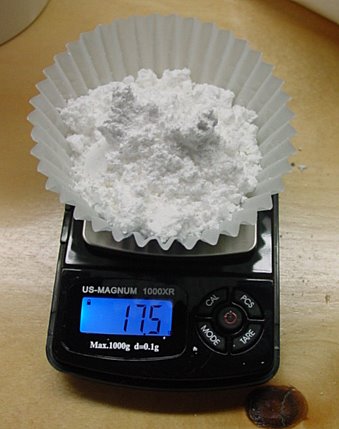
Next, the KNO3, potassium nitrate. Stump remover, fertilizer, etc.

Finally, we add a few grams of dextrin, which is a binder for the grains to come. Dextrin is made by baking corn starch at 400 degrees for several hours until it turns tan to golden brown. it is very easy to do, so don't hesitate making some dextrin.
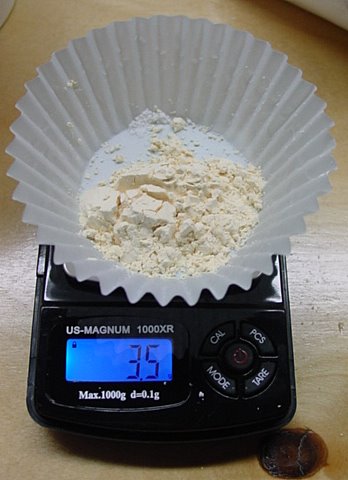
Our goal is to get these two ingredients to be INTIMATELY mixed. If you simply stir them around in a bowl, IT WILL NOT WORK WELL AT ALL. You can use a mortar and pestle if you don't mind hours of tedious grinding, but there are better ways.
All of this is somewhat risky. Nothing pyrotechnic is not, but the propellant we make here is quite stable, moreso than black powder. It is more difficult to ignite, burns less fiercely when unconfined, and in general I am comfortable working with it. If you can make BP, this is easier and a bit safer.
Our options to intimately mix these ingredients:
A ball mill (best) which is what I used:
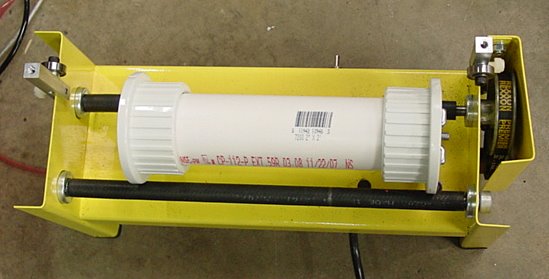
If you ever plan on making this stuff, or black powder, in any quantity greater than a hundred grams, a ball mill is 'da bomb, figuratively. You toss in the raw ingrdients in any form, prilled, chunk, granulated, whatever, turn it on, and hours later you have a starch-fine, intimately mixed powder, ready to be processed. Generally ball-milling combustible mixtures is a bad idea. I will ball mill only BP or this fuel, until I run into another composition that I am comfortable with, that's it. Use non-sparking media like brass or lead, no metal in the jar, etc.
With no ball mill, here's how I'd go about it... Using a flame-proof setup like a portable electric griddle, combine the ingredients and enough water until the mixture forms a thin gruel. If your ingredients are chunky, like prilled KNO3, it will require more time and heat, but essentially you want to heat and stir continuously until what you have left is a bit thicker, like oatmeal that has been sitting on the stove too long. I'd keep the temp at 200 degrees F. or below, just heat it up and get them finely mixed. Remove from the heat, then add small amounts of denatured alcohol, stirring rapidly. The alcohol keeps the grain sizes small as the ingredients crystallize, and also pulls the heat from the mix so it can be handled. You will then have a dough- ball of propellant. I will get there a different way with the ball mill, but the end result - you want a moist dough-ball.
Back to my process. After ball milling, I emptied 1/2 of the powder into a small bucket, and for batch one, added a tiny bit of iron oxide, to test vs. the straight mix.
Iron oxide:
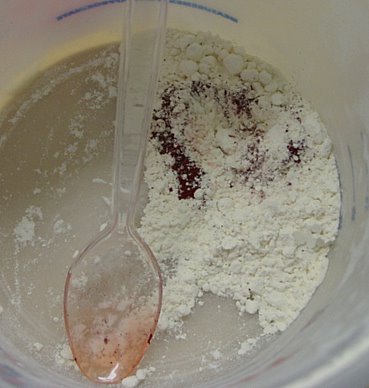
Straight:

I will focus on the iron oxide batch now, since it looks "cooler" being all red and such. It was amazing how little iron oxide completely colored the batch. I added dribbles of 75:25 alcohol:water, or vodka if you are doing a guerilla batch. Use JUST ENOUGH again to form a dough ball. Here, I have a bit too much liquid, but that's OK.
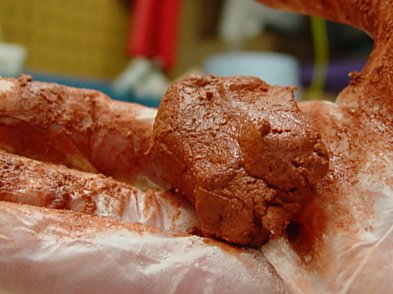
The added dextrin helps hold everything together, for this portion of the process, and the screening. the screening is what will separate the good powder from the crap powder, and is ridiculously easy to do. Position your piece of screen over a pan or flat of clean paper, and "grate" the dough ball, sending showers of powder bits down into the pan. Distribute the powder by moving it around so the wet granules do not end up in a giant pile. We want to avoid manipulating the grains until they have dried, and a big pile of powder will take longer to dry than one distributed thinly.

Allow your grains to dry. It takes less time than one might think due to the grains' surface area, and the fact that we use mostly alcohol. Set the pan out in the sun, or you can blow a small fan onto the grains, and I'd give it at least 8 hours, more is better. You can tell when it's ready... the grains kind of "glue" together, but then separate easily with a bit of manipulation. You can take small samples and burn them WELL AWAY from the main batch, and when done it will burn a bit quicker than a small pile of smokeless, but not as fast as good BP. You'll see later with the videos.
That is it for now. I will take further pics of the final powders, and a video of a burn. I will say that I loaded the white powder into a .22LR once again and had a very satisfying shot from it... plenty of power, modest residue, and an interesting smell!
Once again, I want to stress that I think straight BP is the ideal alternate propellant to smokeless. This is presented here as yet another, even simpler alternative. BE SAFE. While not explosive, both BP and this stuff is MORE dangerous than regular nitro powder. I have zero load data, and am going to make no attempt to do anything but guess, and that guess is this stuff is even milder than BP. With BP I know for a fact that any modern firearm can be loaded with BP rather than nitro powder, and be safely fired. I believe this to also be the case with this stuff, but if you decide to mess with it, use extreme caution and work loads up slowly. The .22 I fired was stuffed full, and showed no signs of stress. The bullt velocity was not as quick as smokeless, and I don't think the pressures are high, but frankly I will stick with BP for my alternate propellant.
buster charlie
April 12 2008
I'd like to contribute this link to the discussion.
On Potassium Nitrite: http://members.aol.com/nonillion/kn-exp.html
I found this, it's in regards to model rocketry but since the goal is pretty much the same for both BP and rocket engines I figured this will be pertinent.
Quote
For the experiments, KN-Sucrose propellant was prepared, rather than KN-
Dextrose or KN-Sorbitol. The reasoning is that higher temperature casting is
required for KN-Sucrose, and would thus be more likely to reveal heat-related
problems. As well, KN-Sucrose has a greater ambient pressure burn rate, which
allows for more precise measurement of any differences in rate between the
products.
This article is about the three common sources of KN. which I imagine is going to play a important role for any of these projects.
Also to the current discussion, I should note this test was done on sucrose based fuel, so it's even more relevant to the current discussion:
I will summarize the article for those wanting the quick answers, but the main article has much more technical data.
First the three main sources of KN:
Quote
1. Chemical grade, typically USP, BP, Technical grade, or similar. The
purity of this grade is high, greater than 99%. Sold in some pharmacies as
saltpetre. Also available from chemical or pyrotechnic supply firms.
2. Fertilizer grade, typically consisting of 98-99% potassium nitrate. Sold as inexpensive 14-0-45 fertilizer, used to increase the nitrate level of soil, and for hydroponics usage.
3. Stump-remover. This is a product that is used to accelerate the decomposition of tree stumps. The amount of potassium nitrate present in this product undoubtedly varies from brand to brand (in fact, some brands are not potassium nitrate based, and are thus useless for propellant, such as BonideTM Stump-Out). Additives may also be present in stump-remover to enhance the effectiveness. Since this is a fairly common and relatively cheap form of potassium nitrate, available at garden shops and hardware stores, the possibility of its use in propellant making is attractive.
Dragon Stump Remover according to the MSDS, contains 99.5% potassium nitrate.
Now for the short version:
1) Lab grade stuff was 99.2% pure, and was ground and oven dried at 200F for 1.5 hours to remove moisture.
2) Fertilizer grade was 98.9% pure but 10-15 years old, and was ground and dried in the same manner as #1.
3) The stump remover was suspected of containing a lye coating. One batch was not washed, and a second batch was washed in methanol to remove the lye. Both were ground and dried as in #1.
The article then describes the various ways of testing the mixtures, but I wont get into the technicals here. Read the link for more info.
Quote
The burn rate measurements clearly showed that the impurities present in
the stump-remover led to a reduced burn rate. The product that was washed to
remove the impurities had a burn rate that was essentially the same as the
chemical grade potassium nitrate. Strands prepared with fertilizer grade
potassium nitrate had a burn rate marginally greater than the chemical grade
product.
The combustion tests showed that the performance of all samples was similar and very near the theoretical value, indicating high combustion efficiency was achieved in the pressure vessel. As with the burn rate results, the stump- remover that was not washed suffered slightly in performance, have a c* value nearly the same as fertilizer based propellant. Interestingly, the stump- remover product that was washed and dried performed as well as the chemical grade product.
It may be concluded that chemical, fertilizer and stump-remover grades of potassium nitrate are essentially equally suitable for oxidizer use in the KN- Sucrose propellant, and surely for the two other "sugar" propellants. Further, it must be noted that:
* Stump-remover grade product must first be thoroughly washed in methanol to remove the coating. This is necessary, not only to enhance performance, but to ensure that melting process safety is maintained. Complete drying in an oven for a minimum of 1.5 hours at 200F is then required to remove residual moisture. Note that Wilson'sTM Stump-remover was the only product tested -- other brands may differ in composition and suitability for use as a propellant oxidizer.
* Fertilizer grade product must be dried in an oven for a minimum of 1.5 hours at 200F to ensure that the burning rate and performance is optimized.
* To ensure optimal performance, chemical grade product should probably be dried in a similar manner to remove residual moisture, even though earlier testing indicated that absorbed moisture is less than one percent.
So from what I'm gathering is a good fertilizer grade bag of KN might really be all you need. The stump remover might be more pure when treated, but for this simple project it seems like a lot more work than necessary if the fertilizer stuff works so well.
Swede
April 12 2008
I agree Buster C. Those are some good resources. Everything I've seen and read says that the big 50 lb bags of KNO3 are very good and will work great for just about anything you'd need KNO3 for. The stump remover if anything is less pure, and it is FAR more expensive, but it is the only source I am aware of that is guaranteed to be at a U.S. Lowe's or Home Depot. The big bags can be found at hydroponics suppliers, big nurseries, garden centers, and the like.
KNO3 is probably the most benign oxidizer we can work with. It is predictable, reasonably safe, and much preferred for beginners (like me!) than other oxidizers like the chlorates (dangerous!), perchlorates, and probably scariest of all potassium permanganate.
KNO3 has uses beyond propellants. The molten salts are a great tempering salt for steel, and will also generate a finish known as "nitre blue" to degreased steel. To do nitre bluing, you have to melt the salts, which is a lot of heat, vs making a solution. Anyway, it is handy stuff!
Oh yes, this also brings up the use of MOLTEN salts as these guys do to make good rocket fuel. I am guessing that there would be a way to make excellent firearms propellant from a molten salts mixture, but it is going to be a bit more hazardous, and the graining especially may be a bit more difficult.
Now I wonder a bit... I have never cast this propellant. Perhaps a big block, cast and cooled, can be grated through a screen to produce a nice grained powder. It's definitely worth a try.
buster charlie
April 12 2008
I'm glad to help the community out. This topic has rekindled my interest in obtaining a BP firearm of some kind.
Fuzzbean
April 12 2008
When you talk about molten salts for a propellant, do you mean melting the potassium nitrate and adding sugar, or what? Adding sugar to molten potassium nitrate would cause an instant fire, it seems to me. I imagine sugar begins to decompose or maybe even burn at temperatures lower than the melting point of potassium nitrate. For the same reason, anyone experimenting with molten salt bluing or heat treating using an oxidizer had best be careful not to drop anything organic or otherwise flammable into the salts. The burning could be a real eruption, splashing the hot salts onto other burnable items and body parts.
My brother told me many years ago that the Viet Cong used to attack his air base with rockets made by melting the sugar and adding powdered potassium nitrate to that, then pouring it or packing it into a pipe. I tried doing this on the kitchen stove once, substituting sodium chlorate for potassium nitrate. Due to the greater reactivity of the chlorate, even that proved to be an unworkable plan.
Swede
April 12 2008
Quote (Fuzzbean @ April 12 2008,11:46)
I tried doing this on the kitchen stove once, substituting sodium chlorate
for potassium nitrate. Due to the greater reactivity of the chlorate, even
that proved to be an unworkable plan.
Ouch! Everything I've read so far on pyrotechnics say "stay away from the chlorates" until you are an expert. When I was a kid, I messed with homemade BP, wasp-gun cap powder (which was truly nuts due to the powdered glass content and the sensitivity of the stuff), progressed to nitrocotton and in 8th grade made nitroglycerin (!!) I know it worked because I was almost blinded by a single drop which detonated in my face. My ears rang for three days. ONE drop.
College - plenty of nitrocotton, nitropaper, nitro-anything. TNT was our goal, but we never got there.
In the AF I was arrested for detonating an "improvised explosive device" on an AF base. Long story, bad ending, and my career was cut short.
Insanity, totally crazy. I can't believe I survived unscathed, and it took me 20 years before I grew up. I'm tired of frightening comps and have no desire right now to do flash compositions or other less-stable mixtures. I'm going to stick with BP, stars, glittery things.
buster charlie
April 12 2008
Quote
his web page describes the "classic" sugar-based rocket propellant
comprised of a fused mixture of Potassium Nitrate serving as the oxidizer, and
Sucrose (table sugar) serving as the fuel and binder.
http://members.aol.com/nonillion/sucrose.html
Quote
The propellant described in this web page is heat cast, using a melting
technique, to form the propellant body, or grain. Although some
experimentalists have utilized the combination of KN and sucrose in the
powdered, pressed form, or cold cast (using a solvent such as water), I have
avoided such for a number of reasons. The two main reasons, however, are
superior mechanical properties of the fused form, and the consistency of
performance that is ensured by an essentially invariable final product that
results from the melting method.
IMAGE 404
Figure 1 -- KNSU propellant grain for the B-200 motor
I'm not gonna quote the entire webpage, but here are the basics...
-the standard ratio of constituents is 65% Potassium Nitrate and 35% Sucrose, by mass.
Now one of the points brought up, for using this ratio vs others in regard to metal rocket nozzles (and this can be important since we use steel gun barrels):
Quote
The combustion temperature rises sharply with increased O/F ratio. At the
65/35 ratio, steel nozzles suffer no erosion, as there is an adequate margin
between the theoretical flame temperature (1450C) and the melting point of
steel (approx. 1500C). At higher O/F ratios, this margin is reduced such that
a small error in weighing during preparation could result in a heat damaged
nozzle (this happened to me once).
Another consequence of using higher O/F ratios is that the consistency of the melted mixture (slurry) is greater. This makes casting more difficult. The effect of using a lower O/F ratio is reduced performance and a slower burning rate. However, the slurry has a lower consistency, which makes casting easier. It is therefore suggested that those who are casting this propellant for the first time use the 60/40 O/F ratio. There is also less tendency for the slurry to caramelize during heating.
Info on sugar
Quote
The Sucrose that I used was the very fine powdered form, commonly referred
to as icing (or confectioners) sugar, rather than the common granular (table)
sugar. This form contains up to 5% cornstarch. Since cornstarch and sucrose
are chemically similar, the effect of this impurity may be neglected. Granular
sugar may be used, it simply needs to be ground to a fine powder first.
some info on the KN, but I posted that above (basically fertilizer grade is the most economical and works fine for this application)
This guy uses a electric coffee grinder for the KN milling.
Quote
The hopper should be half filled, then run the grinder for about 30-40
seconds. To facilitate milling, the grinder should be slowly "gyrated" about
its base. Milling as such will reduce the particle size to an average of 50-
100 microns. As obtained, the potassium nitrate particles are typically 150-
250 microns.
Then more discussion on the viscosity of the melted propellant: Short answer finely milled KN will have to be scooped in, but burn better. More coarsely ground KN will pour into a mold, but not burn as good.
Also, if you use granulated sugar, DO NOT USE THE SAME GRINDER FOR BOTH SUGAR AND KN!
Obviously some particles will build up in the motor compartment over time, so you don't want BOTH chemicals building up in the electric motor compartment!
He mixes the two component in a rotary mixer using a tupperawre container.
Quote
As a guideline, I allowed one hour per hundred grams of powdered
mixture.
He then goes into motor casting, you can read it for the details but this is
going outside the realm of BP substitute.
HERE IS THE ANSWER TO THE ABOVE POST
Quote
The "slurry" casting process involves heating of the powdered mixture until
it becomes molten, then casting into a mould to produce the propellant grain
of the desired shape. The required temperature that the mixture must attain is
just above the melting point of sucrose. The potassium nitrate, which has a
much higher melting point, remains as solid particles. The result is a slurry
of solid oxidizer particles suspended in liquid sucrose medium.
The vessel which I originally used for heating the mixture was a cast iron pot, of about one litre capacity, modified to be held partly submersed in an oil bath. Cast iron retains heat, which is beneficial for maintaining the mixture in a fluid state during the actual pouring operation, important, since the mixture "freezes" rapidly once it begins to cool. More recently, I've been using an oil-free method, which involves heating the mixture directly in a thermostatically controlled electric "deep fryer", with the thermostat set to 380 F.
It is essential, from a long-term safety consideration, that only these methods be employed for heating propellant, the critical intent being that no exposed heating surface being of higher temperature than the melting point of the propellant. For this reason, heating the mixture in a container over an electric or gas stove element is absolutely unacceptable and must never be attempted (actually, common sense tells us this!). Although this propellant is highly tolerant of overheating, we want to keep this feature solely as a valuable safety margin. Suitable protective gear must be worn during the casting operation (see Effects of Overheating during Casting).
Quote
The casting procedure involves first preheating the oil/deep fryer to a
temperature of 380 F, and maintaining this temperature +/- 5 degrees (for the
65/35 ratio; for 60/40 the temperature should be 370 F). Then, starting with a
small amount, the powdered mix is added, and stirred often to assist melting.
One this has melted, more powdered mix is added, and such is continued until
all has been incorporated. Stirring often is important to prevent overheating
, which leads to a greater degree of caramelization, and consequently reduced
performance of the propellant. Caramelization is characterized by a darkening
of the melt. The initial colour of the melted slurry is nearly colourless, but
begins to turn tan colour as caramelization commences. Eventually, the colour
will become that of peanut butter, as the whole mixture becomes fully molten,
and is ready to be cast. A colour darker than this implies that the mixture
has been heated too long, as caramelization is a function of time as well as
temperature. The entire casting operation, from start of melting, to final
pouring, usually took me about 1/2 hour with the oil bath method, twenty
minutes if heated directly in the deep fryer.
Quote
For the neophyte who has never cast any sugar-based propellants, it is
suggested that the grain casting process be first practiced using INERT
propellant. The INERT propellant is prepared in exactly the same manner as
KNSU, with the important exception that table salt (sodium chloride) is
substituted for the potassium nitrate. This "propellant" melts and casts in a
similar manner to the genuine thing, however, INERT propellant is completely
non-combustible and inexpensive.
buster charlie
April 12 2008
Quote
Alternative Casting Methods
There are alternative methods of casting KNSU propellant that other rocketry experimenters have developed. Two methods that I am aware of deserve particular attention. Both involve the inclusion of water and/or corn syrup to the basic propellant ingredients. One method involves dissolving the potassium nitrate and sucrose in water, then boiling until all the water has been eliminated. The suggested ratio of water to potassium nitrate/sucrose is 2 to 3. Interestingly, the thermostat of the heating vessel may be set to a lower temperature than with the slurry method, typically 130 to 150oC. (260 to 300o F.).
Although I have not used this technique to cast an actual propellant grain, I have conducted preliminary experimentation of both the standard 65/35 ratio, as well as the 60/40 ratio. For both, I have have produced small samples of propellant, including strands for burn rate measurement. It was found that the water boils away quite rapidly. An off-white slurry results, which must be heated further to drive out all residual water. This condition is indicated by a slight odour of caramelization. Further heating is done until the colour of the slurry is a light tan. The consistency of the 65/35 rato is definitely thicker than that of the slurry method, and the propellant needs to be packed into the mould rather than poured or scooped. However, it was found that the viscosity of the 60/40 ratio is sufficiently lower such that it can be cast in a manner similar to regular KNSU. Curiously, when the propellant cools and hardens, it is completely dry, unlike propellant prepared by the slurry method, which tends to develop a sticky film immediately after casting. Indeed, the hygroscopic nature of the propellant seems to be reduced...a sample strand that has been left in the open air for 6 months, at humidity levels ranging from 50 to 70%, has remained bone dry.
There are interesting advantages to using water as a medium for the propellant constituents during the heating process. There is no need to premix or to grind up the constituents, as both fully dissolve in the water. Combustion appears to be more efficient -- samples burned showed no sign of residue. Importantly, the water solution would clearly add additional safety to the process, at least during the initial phase where the water content is great. The casting temperature may also be lower. As well, the fact that both potassium nitrate and sucrose are soluble in water should produce a more homogenious propellant, which differs from the "composite" mixture of the heated slurry technique. Burn rate measurements at ambient pressure indicate a burn rate slightly greater than the "composite" version (0.45 cm/s versus 0.40 cm/s, typical). The difference in burn rate at elevated pressure, if any, is currently not known.
Dan Pollino (www.inverseengineering.com) has developed a similar technique, with certain differences. Dan's formulation consists of 60% KN, 36% sucrose, and 4% corn syrup. To this, water is added to the tune of 10% of the constituents mass. The inclusion of the corn syrup apparently improves the fluidity of the melted mixture, which improves castability. This innovative casting method is detailed in Dan's web site.
So this water mix method appears to be something you could look into as an alternative to the cast method as your going to 'screen' the BP substitute anyhow and dont need to 'mold' it into a rocket propellant.
Quote
Safety Precautions
Heated propellant is inherently more hazardous than cool propellant for two reasons. For one thing, being already hot, less energy is required to ignite it. Cool propellant, even if exposed to a flame, takes time to ignite, as the absorbed energy first goes into melting. Hot propellant, being already melted, ignites readily if exposed to a flame. Secondly, the burn rate of hot propellant is much greater. Cool KNSU propellant will burn in the open air at a rate of 0.15 in/sec. Although I have not quantified the burn rate of molten propellant, ad hoc testing indicated it is much greater, perhaps by a factor of five.
During the entire casting operation, as a safety precaution, I would wear protective clothes. These included long leather welder's gloves, leather welder's arm protection and apron, and complete face protection, consisting of an arc welder's head and face shield. (of course, I only used the clear glass in the viewing port, not the darkened glass!). Other sensible precautions were also taken, such as having a fire extinguisher available (although it may not extinguish burning propellant) and keeping anything at all flammable away from the casting operation. I always had a large pail of water nearby (water can extinguish burning propellant by means of heat absorption).
In all the years of my rocketry work, I never had an accident that resulted in injury. Mishaps, and the unexpected, certainly occurred, but because I always took sensible precautionary measures, and considered safety as the number one priority, no harm resulted.
buster charlie
April 12 2008
Found another useful link for KNSU.
Quote
An alternative to melting:
Recrystallized Potassium Nitrate and Sugar
http://www.jamesyawn.com/rcandy/index.htm
On this page here.
http://www.jamesyawn.com/fe2o3/index.html
Quote
Two samples were prepared from the same batch of recrystallized KN/sucrose,
the red sample has 1% Fe2O3 kneaded in.
(I also kneaded the white propellant the same amount to make sure this did not contribute to any differences.)
and
Quote
The precise burn times were 5.92 seconds for the red strand, 11.25 seconds
for the white one.
Thus the catalyzed KN/sucrose burned at 1.8 times the rate of the uncatalyzed propellant.
So it seems even a tiny bit of Iron Oxide will increase the burn rate quite a bit.
One last edit:
http://www.jamesyawn.net/skillet/large/index.html
This is a good step by step guide on the water method using an electric skillet.
buster charlie
April 12 2008
Back to the topic of black powder, here is a short article on making it from that model rocketry site. Now they even admit they're making ignition and ejection charges which are not suitable for firearms, however what may interest the people on this forum is a nice tutorial on how to make your own charcoal suitable for BP.
He uses pine cones ;)
http://www.jamesyawn.net/bp/index.html
A good writeup on the different mixtures of charcoal and KN.
http://www.musketeer.ch/blackpowder/recipe.html
Most interesting is...
Quote
the role of Sulfur in black powder
Contemplating the diagram in Fig. 1, you might ask yourself, why on earth did our ancestors take the trouble to add sulfur at all? That idea first occured to the Swiss artillery in 1875, when "smokeless black powder" was tested. Firing salvos out of a fortification soon made the enemy invisible, due to the heavy smoke of the hefty loads of cannons. Since those tests were done on the eve of the "white-powder" era, the findings soon became obsolete.
A sulfur-free black powder yields only little smoke. When it is used in a rifle, you see only a faint fog. When a percussion rifle is fired, the ignition poses no problems. From a flint lock, you will get a lot of misfires.
So I tested the ignition temperature of (homemade) black powders by increasing the temperature in a laboratory oven in increments of 10°C and found the purpose of sulfur in the black powder mixture:
Ignition Temperatures:
S'peter Charcoal
Sulfur Ignition-Temp.
100 p - 13 p - 12 p 300 deg C
100 p - 27 p - 0 p 440 deg C
p = parts
The sole purpose of sulfur in a black powder mixture is the reduction of the ignition temperature! Note: A good priming powder has allways a high sulfur concentration.
brokengun
April 12 2008
I found a recipe for gun powder using 56 parts potassium nitrate with 48 parts sugar in 84 parts water. and could have up to 3 parts iron oxide to increase burn rate.
The mixture is heated until the potassium nitrate and sugar are dissolved and the water is boiled off to about 1/4 of its original volume. The recipe says this will create a thick sludge.
The recipe calls for the mixture to be dried in the sun.
With the mixture still moist to the touch but not sticky, granulate it by pushing it through a mess screen and allow the particles to dry in the sun.
It suggests using a small screen to control particle size or like swede suggested making some kind of press and extruding to control grain size.
The recipe does call for proper storage and suggest that all cartridges be sealed because the mixture is highly hygroscopic.
Swede
April 12 2008
I love all these recipes. It shows there is definitely a way to do this with sugar and KNO3.
I stopped by Cabela's (FT. Worth) today with every intention of buyng a TC Contender pistol. I've always wanted one, and this project was a perfect excuse. They had to go in back and blow the dust off one... and there was NOT ONE SINGLE BARREL available. It seems T/C is focusing on the "Encore" and the Contender is now a back-shelf deal. I need to do some research.
In the meantime, I can continue to do some basic experiments, because I found they were selling bags of .22LR bullets, just the lead, for the NAA .22 muzzleloader pistol. I can simply pull some .22 cartridges, replace the powder, and seat the new lead bullet. I needed the new bullets because pulling them deforms them pretty badly, and I could not consistently seat them.
The .22 is a lousy cartridge for this but it'll give us some ideas. I'll chronograph a few shots, red vs. white powder, grain size, etc. I need to make some sort of a simple bullet-seating die that will gently and consistently seat the new bullets.
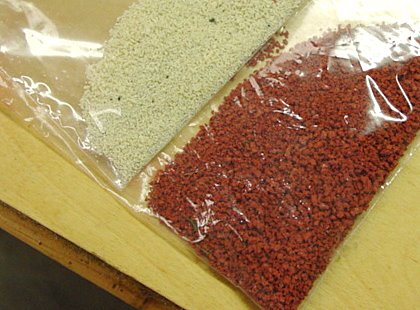
Here are the two powders. I stupidly used a different screen size, thus the grains are different. before testing red vs. white, I will grind the red down to the consistency of the white powder. Also, if you do this yourself, I'd recommend a pretty fine screen size. Look for a tight kitchen strainer rather than a window screen.
Swede
April 12 2008
Here are some burn videos. All are exactly one gram. The red powder was ground a bit to match the white powder. I am using Pyrodex RS as a reference in the first video, because it is a "pseudo BP" much like we are attempting to create. Remember, the speed of the burn doesn't tell us much. Smokeless powder burns slowly unless confined. These powders behave in a similar fashion.
Pyrodex Burn, 1.2 MB
"Red Powder", 1.1 MB
It's interesting, after watching all three of these videos several times in succession, the KS recipes burn almost identically to pyrodex! I'm pretty certain that pyrodex is nothing fancy, and may very well be a KS recipe with some graphite added to it to apeal visually. Wouldn't that be something! A pound of Pyrodex at Cabela's was $22!! We can make a pound of this stuff for maybe $2.
hammermill
April 12 2008
great documentation swede
CAUTIOUS NOTE ALWAYS SUSPECT RECIPE YOU YOURSELF HAD NOT TESTED. TYPOS AND DIFFERENT LEVELS OF JUDGMENT MAY APPLY. ALSO LESS THAN PURE CHEMICALS MAY EFFECT THE FINAL RESULT
HAVING SAID THAT i am not sure of pyro dex but you may be on the right track
it is too bad some primed 22 cal cases can be obtained.
Swede
April 13 2008
After that last post I feel I need to say, this is NOT pyrodex NOR can it be considered a safe propellant until significant testing is done. Does anyone know of a simple way to measure chamber pressure? The Mythbusters use all sorts of cheap, off the shelf items to measure things like "G" forces, etc. Something simple that does not require a research lab. I will happily take an old barrel, drill it for a probe or some sort of pressure-measurement device, and launch projectiles from it remotely, to test chamber pressures. I could test BP, pyrodex, 777, and alternate propellants. There is no way to go any further, safely, without this crucial system.
I will gladly launch .22 cases full of this stuff in my old bolt-action rifle, and chrono them, but that tells us very little about what sort of pressures we are getting. We've all seen load data where the pressures are dangerously high, but then fall too rapidly, and the resulting velocity of the bullet is normal, or less than normal. So bullet velocity does not give us enough information.
hammermill
April 13 2008
i thought i would pull up pyrodex,s msds which is under the dealer section of the home page at hodgen
it contains the usual suspects charchol potasium nitrate, potasium percholate graphite and sulpher
for triple 7
potasium nitrate potassium perchlorate charchol and graphite
maybe fuzzbean knowsomething on this but i would wonder about using copper slugs to measure pressure
Swede
April 13 2008
Interesting that they would use the perchlorate. I've got a feeling that the perchlorate gives it more energy or a different pressure curve than KNO3 alone would give, with the same fuels. Their goal from the outset was to make a volumetric equivalent for BP. The good news, WE do not need to make a volumetric equivalent, we just need to make it safe. So it might be entirely possible to use this stuff as a propellant, perhaps requiring a larger volume than BP. There's zero doubt that a finer granulation is going to make a much more energetic powder... I can see it when I burnt he samples. You can go too far - it can't be starch-like "meal" powder because ignition might become more of a problem, or pressures may peak at the wrong time. We want the burn to accelerate a bit more slowly, rather than peak too quickly, which might spike the pressure too high.
I'm thinking along the lines of grains sized much like a fine ball powder or maybe 4F BP. The grains I stuffed in those .22 cases was quite coarse and it still worked well.
I will post a query in the reloading section. There are some smart guys there that may not be following this thread.
cheme2010
April 13 2008
Cool! I had not been following this thread, but I read through it today and I am impressed. One thought that came to me while reading this is that you could use a Taylor sieve (or equivalent) to granulate the powder. Taylor sieves are used for sizing particles and come in a bunch of opening sizes, so you could find out what size works best. This Webpage shows the mesh opening sizes
The sieves are expensive (I think about $70 for one), but if you asked around at pavement testing labs or similar places, you could probably get a few sizes for free, if you were patient. The labs are required to replace their sieves every now and then so that the mesh openings are the proper size and they usually just throw them away. I realize that this is not exactly in the "easy to get" category, but I though I would mention it anyway.
Thanks for your work, this is really cool.
Fuzzbean
April 14 2008
I think you could easily rig something up to test relative pressures.
Say get a piece of heavy barrel of average size bore, maybe .45 caliber to split the line between smokeless and "serious" blackpowder calibers. Then drill and tap a hole, maybe 3/8"-24, close to the breech end. Then make a cylinder thing out of 5/8" rod to screw in there on one end, with a connecting 1/8" hole and a .3135" reamed bore coming out the other end. Use a standard 5/16" dowel pin as a piston, ground perfectly flat on the outer end. Then tap the end of the cylinder 3/8-16 for an anvil screw, which would also be perfectly flat on the end. And drill a cross hole about 1/4" diameter, centered .100" above where the top of the piston would be when all the way down. Then you could use solid-core solder (or copper wire if necessary) as your crusher material, fed through the cross hole at 90 degrees to the piston. You don't want the piston accumulating any inertia, so tighten the anvil screw down so there is no play. Possibly to some uniform torque.
After firing, just mike the thickness of the crushed part of the wire. Obviously the thickness of the wire would change easily at first, with smaller changes in measurement representing larger changes in pressure later on. But I think by using a continuous length of solder or wire, you could get reasonably consistent results.
You'd want to change things a bit if you were expecting full smokeless pressures, or if you were using .22 caliber barrels, or 12 gauge plastic cartridges or whatever, but I think this basic plan would work well.
I've made up barrels for pressure testing ammo before, using piezo-electric sensors in a universal receiver. We had a kit of special tools to form the port, which was put into barrels of about 1.5" OD. A small hole of about 3mm connected to the bore, then we counterbored that to maybe 10mm and tapped the counterbore. The flat bottom of the counterbore was burnished with a tool that had a flat cross-grooved or serrated end. That tool was spun by hand using a socket wrench, while another wrench was used to turn a threaded sleeve in the hole over it to apply pressure. That wrench only needed the torque of one finger applied to it. I never took part in the actual testing, but apparently the sensor sealed tight against the burnished bottom of the counterbore. If I remember right, the port was into the chamber area and the brass was allowed to blow out into it for modern cartridges. Though it seems like that would be a bad plan to have that piece of brass impacting things like that.
geodkyt
What Fuzzbean has just described (for all you who missed it) is the
traditional method of testing chamber pressure. The tough part is calibrating
your crusher materials.
Still, for anyone who cares to try this at home, do your pressure fires as if you expect the whole gun to explode, just in case the test rig "spontaneously self-disassembles". Separate yourself and anything you'd care if it got "dinged" (including your neighbors) by blocking line of sight (and a bit more) with enough barrier that it would stop a fired slug.
Jaymo
April 14 2008
Why not try using one of those Dixie Gun Works powder testers?
Fuzzbean
April 15 2008
Is that the old kind that looks a bit like a pistol and blows a swinging "lid" off the "barrel" against some kind resistance?
Those are good for comparing different batches of blackpowder to see which is the quickest burning when loosely confined, but would not be very useful to show the relative pressures ultimately produced when radically different propellants were compared. Probably Pyrodex and especially smokeless would measure much weaker than blackpowder in such tester, because they burn so much slower when unconfined. Of course that would be opposite to the actual pressure and safety situation when those propellants were fired in a gun.
Swede
April 15 2008
Cheme, thank you for the link. As part of my new Pyro hobby, I am constructing 5 stainless sieves just for that sort of task. I've built the frames out of wood and given them about 30 coats of polyurethane so I can really wash them well with water. They should allow me to sieve nicely.
Fuzzbean, I really like your idea for the soft wire. I've come to the conclusion that the best accuracy we are going to get with a homebrew test rig is a muzzleloader, with a gas port or piston located directly over the powder. That way, there's no problems with brass, and we'll be more consistent with pressures because the entire breech is 100% sealed.
We could check and see if there is true consistency with the method by simply executing a series of tests with Goex 3F right out of the can. Measure an EXACT amount of powder for each test. If the soft lead wire (I'd go solid wire, not flux core) is consistently deformed, it's a winner. The next step would be a reduced load of Goex 3F, and again, if we see a reduced crush, it's further confirmation we're on the correct track.
I posted on a pressure-sensing mylar film in the reloading section, and that may very well work too, with the same rig! All we need is a piston. Also, by varying the dimensions of the piston in terms of surface area, we can multiply (or divide) the force and perhaps gain better resolution. Idea - a variable gas tap as used on some machine guns. Vary the orifice size to deliver more or less pressure to the piston, and again perhaps gain some resolution.
Fun stuff!
Cobbler
April 15 2008
...so your test rig would have a piston for the piezo strip and a piston for the crusher
A V-twin test rig... I like it!
hammermill
April 15 2008
let me see if i am processing this right
we use goex to give us a baseline of crush to the solder
and then if we dont crush the wire as much as the baseline its lower pressure
if we crush more its higher pressure
the amount of crush is not linear.
am i on the right track here
as a side note this weeks skylighter newsletter has some interesting notes on useing a motor to test powders by measuring flight times.
this does not however help us with chamber pressure.
geodkyt
April 15 2008
Hammermill -- exactly correct, especially on the "non-linear" part.
When copper crush gauges are (were) used industrially, you had to compare the crush results with samples of the same lot of material crushed under a known pressure in a press. They also sometimes "tweaked" the results to remoe the error induced by inertia by pre-stressing the copper test slugs to just under the expected peak pressure.
Swede
April 15 2008
It's admittedly relatively crude, and I would not completely rely on any homebrew system short of a full-up datalogging digital setup, but again I think if we can generate repeatable results, that would go a long way towards giving me confidence in the system. The non-linearity doesn't bug me too much so long as we can confirm that indeed, less crush = less pressure.
One issue: the data will be valid for the specific bore size, projectile weight, and amount of powder, but like Fuzzbean says, something like a .45 would be a good all-around starting point. Additional data will be delivered by a regular chronograph. Normally, higher pressures create faster velocities, and from what I've seen so far, this powder is not as hot as good BP. If we get less crush, AND lower velocities, I'd be comfortable.
Fuzzbean
April 15 2008
So if the wire comes squirting out the sides of the piston like foil, and your muzzle velocity is 500 fps, then you KNOW you're on the wrong track.
Bismarck
April 15 2008
The whole project is very interesting. It seems to me that an alternative propellant made of KNO3 and sugar would leave less residue in the barrel, and burn almost completely. I wonder if something like that can be tweaked to give similar ballistic properties with BP.
hammermill
April 15 2008
a look at pc based data logers show a drdake pc based data logger that the tech sheet says will do up to 5000 tests a sec and record voltage
the chart recorders are too slow as are digital multi meters with peak hold memorys.
Swede
April 16 2008
Quote (Fuzzbean @ April 15 2008,17:12)
So if the wire comes squirting out the sides of the piston like foil, and
your muzzle velocity is 500 fps, then you KNOW you're on the wrong
track.
HAHA! I think that would indicate a VERY fast burn, as in, a full-up HE going off in there, a small amount.
Picture a flash powder, as used in salutes or M-80's. WAAAAY too fast. You put a tiny amount in the test rig, and fire. Since the amount is very small, the total energy is low, and the best it can do is push that bullet at 500 fps. But it burns so fast we get an instantaneous pressure spike that is very high before the bullet can move an inch. Not good.
People think "explosive" when they think of gunpowder, but the ideal propellant is more like rocket fuel. Burns slowly unconfined, and as the pressure rises, the burning accelerates, and gives us the nice push we need.
Worst case would be MOLTEN solder splashing out from the rig!
I've got a huge number of .50 caliber round balls. I think the rig will be a .50 smoothbore muzzleloader, Carbon steel DOM tube maybe a foot long, but the breech end will be capped, welded closed, and encased in a big block of good steel that will contain the piston assembly.
Drill a touch hole like a flintlock, weld on a little pan, and fire the gun with a fuse to a BP priming charge in the pan.
Or, use a nipple and a #11 cap, and set up a simple pivoting hammer powered by gravity, or a spring.
Swede
April 16 2008
I am AMAZED at how cheap decent digital scales have become on eBay. If you need a scale capable of 0.01 gram resolution, execute a search
DIGITAL SCALE .01
and you get about 700 hits! I think I am going to need 0.01 gram resolution to do this. I can use my old reloading scale, but for $15 or so, I can get a gee-whiz digital that will read in grams, grains, carats, ounces, and have a tare feature. Here's a cheap one:
hammermill
April 16 2008
swede dont forget to do this right you will need a white lab coat,pocket protector,starched shirt and tie.
sound like your on your way.
yesterday i ordered some stuff from skylighter and they threw in a scale with the purchase. all good ken
coyote65
April 16 2008
Swede that purchase may put you on the list. If the DEA pays a visit just tell them its for weighing postage.
Terry
April 16 2008
Quote
Swede that purchase may put you on the list. If the DEA pays a visit just
tell them its for weighing postage.
With all that sugar laying around they will never believe that... tell 'em your bakeing cookies
take care
geodkyt
April 16 2008
"And today, a combined ATFE/DEA raid shut down the nefarious operations of the Swede, leader of the notorious Keebler narco/eco terrorist movement..."
drhall762
April 16 2008
I have had a personal interest in this subject since I was about 12 years old. That has been a long time ago. I have found this thread to be as interesting as any I have read in a long time. Early on Swede makes a reference to Skylighter.com. I had to check them out. If no one has yet mentioned it, these folks have a wealth of information on BP and its production. Currently, you can sign-up for free to access their newsletter. Great stuff!
If you are truly interested in this area, check them out.
Stefun
April 16 2008
Quote (Bismarck @ April 15 2008,21:45)
It seems to me that an alternative propellant made of KNO3 and sugar would
leave less residue in the barrel, and burn almost completely. I wonder if
something like that can be tweaked to give similar ballistic properties with
BP.
Actually, this what we used when I was a youngster. We built a muzzleloader (and much more), caliber about 16mm, and used this mixture as propellant.
Hm, it worked, no problem to shoot through 8mm steel plate, but there seemed to be a pressure at which it didn't burn but detonate - had realy bad results when trying to build a rocket, it worked at very small size, but detonated when more powder was used.
Back to the cannon, as I remember, our barrel was made of 7 water pipes of different size, cocentrical, welded together at the rear end and the gaps between the pipes filled with lead. The ignition hole was drilled through all these layers of steel and lead - bad idea. The hot gases melted away some lead at every shot, weakening the array, when we saw that the barrel began to bulge out we loaded a heavy overdose and blew the gun up.
For ignition we used straw pipes filled with the same mixture.
Another issue with this propellant is rust - in corrosive primers there is so little of this stuff, but already a problem, you guess what happens to iron when the whole powder is of that kind...
buster charlie
April 16 2008
Check out this skylighter newsletter on a 'better' homemade BP without a ball mill.
http://www.skylighter.com/skylighter_info_pages/article.asp?Item=115
hammermill
April 16 2008
i was going to try the red gum variation.
seing as they threw in a pound of the gum adigital scale and one of the hot air ballons the grand kids love them.
summer is comming on and i got to get stocked up.
drhall762
April 17 2008
Had another thought. I like BP. I hate flintlocks. Percussion or cartridge BP is the way I like to go.
Now the other thought. Primers or priming compound. Any insight out there? I know priming compounds are shock sensitive. Forster markets a Tap-O-Cap rig for making #11 percussion caps from aluminum drink cans and toy roll caps. Any first hand experience?
As for cartridge primers, Berdan are probably easier to fabricate as the anvil is part of the case not the primer.
Maybe this is a perfect spot for the new electrically fired BP guns.
Swede
April 17 2008
Quote (buster charlie @ April 16 2008,19:10)
Check out this skylighter newsletter
That's a really good article. I like his methodical approach. In the Pyro hobby, everyone gets all excited over pressing their moist BP into pucks, then screening the pucks. I've tried it, saw no difference in performance, and it was a mess. Really, the only thing it gives you is DENSE powder, and that's a good thing actually for firearms, but if you measure by weight, I don't think it's necessary.
Thought - You want to REALLY get as much BP as possible into a .45 LC case... then, yes, pressing may help. But for a regular muzzleloader, I don't think it's needed.
My favorite BP method so far is the dextrin addition, turned into dough with 50:50 alcohol and water, and screening. It was very easy, made good, tough grains, and performs perfectly.
Dave, on primers, I do agree that it is a needed adjunct to this. I need to confer with the mods, but I think I have found a recipe for a primer compound that uses two readily available chemicals, plus bubbled acetylene gas from either calcium carbide or a torch bottle. But primer compounds are scary, and in any quantity beyond a few grains, dangerous. It is a whole different world in terms of safety, from making BP.
I would also suspect that emergency priming compounds can be made by removing the powder from those little red plastic caps (we called them "wasp guns" when we were kids) but that is for another thread.
I've got some willow charcoal on the mill right now. For this batch, I am going to try red gum + alcohol rather than dextrin.
geodkyt
April 17 2008
Someone here (Fuzzbean, maybe?) did a writeup on the Tap-O-Cap percussion cap punch a few months back...
cuslog
April 17 2008
I've been following this thread with some interest.
Today, I purchased a bag of Potassium Nitrate fertilizer.
Earlier in this thread, someone listed the fertilizer grade of KNO3 as 14-0- 45.
The bag I got says "13-0-46 Acidic Potassium Nitrate PH 3-4" Low in Chlorine
Can anyone give me some insight into this?
Stefun
April 17 2008
A thought about ignition:
Do you think it's possible to ignit BP with a spark? I'm thinking of a primer, with a short, thin piece of wire (or a spike touching a berdan-like bridge in the cartridge) coverd with BP, and a rather large capacitor array, 5000 Farrad at 50V give an impressive Bang when shortned.
The "firing pin" would be the switch that hits the insulated elektrode in the cartridge, contakt area should be at least 10 times the cross section of the wire/spike, I guess.
I use 2500 Farrad at 10-50V to burn away short curcuits inside elektrical motors, there is a lot of energy released in a very small area. There are no fancy, high power batteries necessery to load the capacitors, simple 9v batteries in series would do the job several times.
drhall762
April 17 2008
You may be on to something. Got a schematic in mind? A picture is worth a thousand words.
hammermill
April 17 2008
i would leave primers for a differient topic if things reach the point of needing to make primers a good flint or matchlock may prove better and more reliable.
scasa
April 17 2008
Quote (Swede @ April 17 2008,11:23)
In the Pyro hobby, everyone gets all excited over pressing their moist BP
into pucks, then screening the pucks.
Any thoughts on making pellets like the ones used in muzzleloaders. Maybe a puck for a morter.
hammermill
April 17 2008
you know i never thought of that when i start the next batch i will try some in the golf ball motor for some reason i dont expect the same performance
Spartiate
April 17 2008
RNX (nitrated epoxy) might be perfect in this role.
big art
April 19 2008
drhall762 there is an interresting book at www.deltapress.com that deals with homemade primers. It's 85 pages and covers primers from muskets to modern weapons. search for c-9335 for complete desciption of book. cost is $17.95
Swede
April 19 2008
Quote (cuslog @ April 17 2008,13:35)
The bag I got says "13-0-46 Acidic Potassium Nitrate PH 3-4" Low in
Chlorine
Cuslog, you've got yourself a fine bag of KNO3. A lot of that gobbledy-gook they put on the package is designed to hide the fact that yes it is relatively pure potassium nitrate.
Now all you need to do is buy a couple of those 5 pound bags of dusting sulfur for plants, cook up about 20 lb of softwood (or newspaper) charcoal, and you can whip up a 60 lb batch of BP!
Where did you get the KNO3 fertilizer? I have not found it yet in bulk.
Swede
April 19 2008
Scasa, it's really easy to press BP into pellets. Let's say you want a .50 cal pellet... get a piece of brass tube with the desired bore, and when the BP is in the dough stage:

Weigh a lump (factor in the added water:alcohol) and put it in the tube. With a close-fitting ram, use an arbor press, hydraulic press, or a big vise (the hydraulic press is FAR and away the best choice) to press the BP. It will come out as a hard little pellet with plenty of strength. Let it dry for several days, at least, maybe 10 or more. The burn rate might be a bit slower, so some additional powder may be in order. This is what they look like:

These pellets are pretty crummy because I did not use good tooling... just jammed some BP in a hole and used a sloppy rod as a piston. But they had plenty of strength, despite the flakes you see.
Swede
April 19 2008
The alternate powder test is alive and well. Right now I am thinking up a way to measure pressure, and have some components coming. I will also make some small batches of powder, with different % of components. I will try 55:45, 65:35, and 72:28 KNO3:Sucrose. Some trace of iron oxide and dextrin. One of those three will be best. From there, we can refine it even further. And we need to come up with a name for this stuff.
"Zombiedex" - when the world really has come to an end!
Sucrodex, SucroBoom, Guanodex (in honor of Bat Guano KNO3) Any others? I think we should form a consortium, get rich selling this stuff for $6 lb.
"Sick of $25 for a pound of powder? Try new Guanodex™ propellant! All of the boom, at a sweet low price!"
hammermill
April 19 2008
did you have a strain gauge coming from the one company you posted about?
cuslog
April 19 2008
I bought a 25 KG bag at the local "Farm and Garden" store - $60.00
"Kemira" brand.
My initial inquiry was for "stump remover", they didn't sell anything packaged as such but said all the locals just buy this fertilizer for that purpose (they also sell it in the "self serve - scoop and bag your own" for $3.00 per 100 grams).
I also want to try this for composting wood waste - I own a log home company - we have a lot of wood waste. Might even try my own charcoal, anyone ever tried Douglas Fir charcoal ?
Swede
April 19 2008
cuslog - pretty much any soft wood makes great BP. Pine has been mentioned, I'd bet Douglas fir would be awesome. And yes the KNO3 applies to compost or organic trash simply feeds the good bacteria big-time, and the whole thing accelerates (the decomposition) wildly. The other thing is, if the decomp is going too slow, you can burn the wood and it'll burn great being saturated with KNO3.
Hammermill, I have some free samples of that very expensive pressure- indicating mylar film coming. I'm going to try that, PLUS I'm going to try Fuzzbean's crusher theory with lead wire solder. While all that is going on, I'm going to make GeneT's strain gauge device and perhaps I'll be able to do both types of test at the same time, plus the chronograph. The plan for now is patched .490 round ball out of a smoothbore barrel.
hammermill
April 19 2008
the article on strain gauges and the use of strain gauges from the rocketry site was interesting and worth looking into.
as a interesting side note i stuffed a couple backwoodsman magazines in my kit for turkey hunting and ran across a reprinted article of grandmas black powder.
she extracted her potassium from the white crust in the chicken pen soil that she collected
next she pored boiling water into a pail filled with this soil and having a perforated bottom and collected this liquid to boil down and concentrate
after scraping off impurities and more simmering to reduce the volume of liquid it was allowed to cool and the Niger crystals would form.
these were washed and filtered leaving a pile of salt peter.
this was mixed with sugar from sorghum in about a 50/50 mix and simmered until really thick
it was then poured onto a Cookie sheet to dry
next step was to break it up and sift it with the fines being ground up more for priming the pan.
as the family hunted squirrels it was used in a 32 caliber black powder flintlock rifle
gee no sulphur or charcoal
Swede
April 19 2008
Yep, very little new under the sun with stuff like this with the exception of some of the more advanced binders and such used by the rocket boys.
It's very tempting to try adding more energetic materials, but in keeping with the spirit of the project (creating both good BP and an alternate propellant from simple materials) I will not do so.
After making many different small batches, it is very easy to get mixed up as to what a composition is, so I have created a log and a labeling system. The very first OFFICIAL batch of Guanidex™ is on the mill, labeled GU-01, a 300 gram batch that is 60:40 KNO3:Sucrose + 4% iron oxide and 4% dextrin. The other two batches will have identical iron oxide and dextrin additions so the only variable will become the ratio of KNO3 and sucrose. When we have that nailed, then it would be time to play with the iron oxide and the dextrin.
Machine_smith
April 19 2008
I don't know if this has any pertinance but there's a grade school experiment where you try to burn a sugar cube but it'll just melt and smell like caramel. But if you dip one of the corners of the sugar cube in the ashtray (That sort of gives away my age if the teacher had an ashtray!) Anyway, the sugar cube would then burn with a blue flame. The ash acts a catalyst for the reaction to take place. I don't know what part of the ashes are the actual catalyst but since we're dealing with sugar I though I'd mention it.
buster charlie
April 19 2008
If I didn't mention this before, red iron oxide powder is available at home depot as a coloring agent for grout and concrete.
If you read back to one of the quotes on the sucrose rocket, he mentioned an 'ideal' KN to sucrose ratio, and mentioned if you started going too high you'd increase the rocket nozzle erosion as the burn temp reaches the melting point of steel.
now i know with a rocket motor it is doing a continuous burn so it has more potential for erosion, but i'd still be worried about erosion of the gun barrel if the mixture is too hot.
Swede
April 20 2008
Quote (Machine_smith @ April 19 2008,17:29)
Anyway, the sugar cube would then burn with a blue flame.
That's pretty interesting. I'll try a small burn with some added ash. You never know, it just might do something for the mix.
Swede
April 20 2008
Here we go... First serious batch of the new propellant. 300 gram batch that is 60:40 KNO3:Sucrose + 4% iron oxide and 4% dextrin. I ball milled it with brass media for about 5 hours.

One thing I noted immediately as I tried to separate the powder from the brass is that THIS STUFF IS STICKY. The brass was coated about 1/16" and the insides of the jar were thick with the coated powder. Uh oh. My guess is that there was a bit of moisture in the components, and that activated the dextrin a bit. I am going to have to solve this or it is going to be a real pain to deal with. Perhaps pre-baking the separate components. Look at the gluey mess...
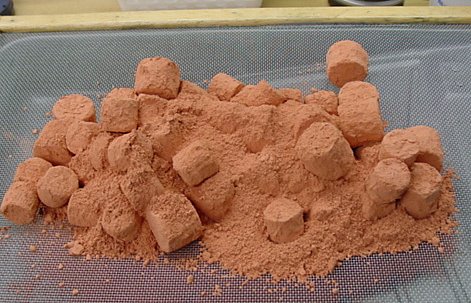
I separated the brass pieces by hand, and tried to force the powder through the screen. I tossed the brass into a neat device I bought at Cabelas called a media separator, which is designed to separate brass polishing media like corncob from your polished brass.

This worked like a champ. What a great tool for this sort of thing. A few minutes turning it by hand, and 90% of the coated-on powder was separated and added to the pile.
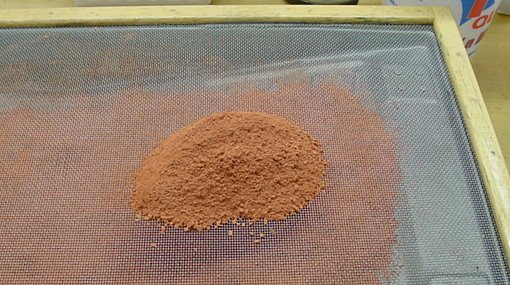
The screen over the paint pan is an incredibly handy tool. If anyone has a desire to mess with this sort of thing, a screen device is necessary, and I made this one to fit over the pan. All of the powder is captured in the pan, which was maybe $3, and teflon-coated to boot.

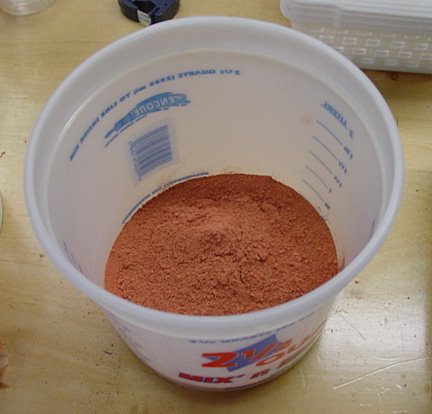
Next will be the dough stage. Guanidex™ GU-1 will soon come to life as a serious propellant! I actually made a miniature sizing die for .22LR cases, and with the 36 grain NAA mini-bullets, I am set up to reload rimfire! This will be a basic test to see if it is going to be worth pursuing a more advanced test rig. All I will be looking at is bullet velocity, and to see if there are signs of excess pressure. Not that I would know what to look for with a rimfire... maybe cracked brass? I'm not too concerned that I am going to blow up a .22 bolt gun.
I have for the initial test some reloaded .22's with the following
1) The original smokeless charge, but a new bullet
2) Goex 3FG BP
3) My best BP
4) Green-mixed (low grade) KNO3:Sucrose
We'll see what happens!
Initial report: The as-milled (corn-starch fine) powder burns beautifully. But when I made a dough and tried to screen it - catastrophe! It was like trying to screen epoxy putty. As it flowed through the screen, it did not break off and fall free, but simply congealed on the other side. I've got it cut into some really fine pieces, and it's going to have to dry - for a LONG time!
The culprit is probably the dextrin.
page 20
hammermill
April 20 2008
i don't know which chemicals pick up the moisture but drying them cant hurt for sure.
mite not hurt to get a small toaster oven for that momma swede may object to you using here oven.
last time you did a bake on finish didn't the gun come out with BBQ sauce on them
Cobbler
April 21 2008
For using 22LR as a test platform, a semi auto gun may provide more indicators of something going overboard. The bolt gun will hold it until it can't anymore... a semi auto will show progressively more signs of something going too hot.
buster charlie
April 21 2008
Could there be anything learned from the blowback from the cartridge?
What if you had a 'blowback sled' of sorts, imagine a .22 lr blowback rifle without a 'rear end'. the bolt rides on maybe two guide rods or a channel/rail. So when the gun fires the cartridge pushes the bolt back, but instead of being returned by a recoil spring the bolt just keeps on moving back until it runs out of energy.
Would the distance the bolt travels (without a return spring) provide any useful information for relative cartridge pressure?
Swede
April 21 2008
Well, I checked the "powder" I put out to dry last night, and it is worse than ever! The mix is hydroscopic and is drawing water in from the air. If I had some direct sunlight, it'll dry, or I guess an oven on low, but I dislike the concept of water + dextrin in this mix. I don't even think it needs dextrin. I may scrap the whole batch and start over, and this time execute the granulation by making an alcohol-only dough mass and screening that. Regardless of the method of granulation, the grains will need to be dried in sunlight or some other low-humidity method. There is no getting away from that. In high humidity, these grains are simply going to melt.
It's odd, the first very small batches I made (page 12 or so) behaved perfectly, grained well, and in storage in ziploc bags has not shown the slightest tendency to cake or clump. This powder will work, I just need to come up with an easy method of granulation.
Spartiate
April 21 2008
Instead of no backplate / spring, you could build a "constant recoil force" semi (extended receiver so that the bolt never contacts the backplate--should be very easy in a .22), and measure how far back the bolt recoils against spring pressure.
You could even get technical and set up some sort of measuring device with magnets. A mechanical spring might not even be required if you were able to do some sort of linear induction / reverse solenoid arrangement. It is still early in this time zone and I'm just thinking out loud. I didn't do that well in EE , and I'm not sure exactly how I'd set this up.
Cobbler
April 21 2008
The free recoiling semiauto 22 would yeild a bunch of valuable information, especially if coupled with an "old school" balistic pendulum such as the one described in PO Ackley's "Manual for Shooters and Reloaders, Vol I". I built such a pendulum as a college physics project years ago and the results were amazingly accurate.
Because the ballistic pendulum operates on the principle of Conservation of Momentum, coming up with a similar way to measure the rearward movement of the bolt would supply you with a wealth of data on the back side. The measuring technique for the bolt could be as simple as the technique Ackley describes in his book for the pendulum.
The data from this coupled with the evidence provided by the spent cases should be able to tell you everything you need to know.
Fuzzbean
April 21 2008
You mean REALLY technical, and have the bolt push a refrigerator magnet along a strip of steel to mark its point of farthest travel?
I like the idea of a long weak spring. The bolt could be heavy enough to handle any reasonable pressure, just make it twice as heavy as a 10/22 bolt. The firing mechanism could be fully contained in the bolt, and triggered by simply pulling a pin out with a string at 90 degrees to the recoil travel.
Hurry up and do all this stuff, Swede. Have you got that pressure gun with the crusher mechanism built yet?
hammermill
April 21 2008
swede i would not be suprised if most of the powders made with sugar are not good moisture asorbers.
nat a suggestion but if the sugar was hot enough to crack when mixed with the other chemicals it might improve its moisture resistance. well a little
guess you just need to keep your powder dry hi hi
maybe a pan with a light bulb underneath would do the trick
Swede
April 21 2008
Well, I had work all day, came back to check the drying (it's under a continuous fan) and it's a bit drier, but overall it's a real mess. It's like handling thickened elmer's glue. This is all very odd as the first small batches I did went off without a hitch and granulated beautifully.
Some considerations - skip any/all binders, dough with just alcohol, screen immediately, dry it, and store it. Get it out of the air. I think this stuff needs to be granulated immediately, as some of the smaller chunks I had drying were like hard rock candy, and the larger pieces were still sticky. Once granulated, you can put it in the sun, or maybe under a lamp, but if you wait, I get the feeling that it would be hell to granulate. And this is why I don't think it would ever be practical to cast this stuff, or cook it on a stove, and then attempt to get good grains. You need to go from fine powder, to a non-water based dough immediately, to grains, then dry.
The BP was INFINITELY easier to turn into nice grains.
I tried a cool experiment. In a ziploc, I added small proportions of sucrose and KNO3, already powdered, added a touch of iron oxide, and simply mixed it in the bag. The iron oxide acted as a kind of mixing indicator... when the red was evenly distributed, the mixing was as done as it was going to get with this method. This may be the true, quick basement powder we seek, rather than ball-milling. The only drawback that I can see is that the KNO3 needs to be VERY fine. We can get confectioner's sugar, but the only way to make talc- fine KNO3 is in a mill.
Anyway, I'll try adding some denatured alcohol to this guerilla batch, dough, and grain... we'll see how it burns.
Swede
April 22 2008
I gave up trying to salvage the first batch, and simply dumped it in the garden to help fertilize. No biggie - these components are ridiculously cheap. I am making it overly complicated, and am going to try a more simple method. Unfortunately I have a heavy work load this week and don't know if I will be able to accomplish much, but I am into this experiment and will work to a conclusion, one way or the other!
drhall762
April 22 2008
Read an old book (1937), Fortunes in Formulas, the section on BP states that after all the green mixing, ball milling, wet mixing and grinding, the powder is compressed hydraulically and reground. It stated that the compression aids in the burn rate. I hope to get a chance to scan the relevant info and upload it this weekend. Also, OT, it had a neat section on cordite.
Swede
April 22 2008
Update - the batch mixed in the baggie, even though the powders were very, very fine to begin with, was just sad... it was SLOO-OOOW burning and left behind unacceptable amount of solids. This says that somehow the two chemicals MUST become very intimate, either mechanically, or through some sort of a solution.
The so-called "CIA Method" of making BP does work nicely. It was the first batch of BP I made in this thread, and the essence is this - you boil in water the chemicals until it is fairly thick, like oatmeal. You then remove from heat, and rapidly add denatured alcohol, stirring wildly. The alcohol flashes to a boil, and what the alcohol physically does is the KNO3, which is definitely dissolved in the water, instantly crystallizes into ultra-fine solids, and there are quite intimate with the sugars. The problem I forsee...
The charcoal and sulfur both in BP are insoluble. The sucrose is very soluble, so rather than a solid mass, what you will have is a syrup after you bring the mass to a boil. I don't know what adding alcohol would do. Probably nothing.
Perhaps what is needed is some sort of insoluble carrier. In the fireworks field, it is very common to moisten vegetable matter like rice hulls, even rice krispies, and then mix that with very fine "meal" BP, producing a fluffy but potent explosive mixture. How about this - something like wheat bran. The wheat bran becomes a sort of "carrier" and will also perhaps act as a fuel. You create a stove-top breakfast mash except add KNO3; the alcohol goes in, and each grain of "gunpowder" is literally a tiny piece of wheat bran, completely saturated in KNO3 and sugar. This would probably handle beautifully. Another carrier may simply be 10% sulfur.
I'd like to create a method that does not involve ball milling, and that leaves cooking, because green-mix powder, unless you mortar and pestle for 5 hours, is just bad. Any thoughts? What could I use besides wheat bran? It needs to be insoluble, yet soak up the solution.
I'll keep researching - but so far KNO3 and sucrose, while seemingly a pretty potent propellant, is not easy to work with.
Spartiate
April 22 2008
Cream of Wheat / Farina?
Fuzzbean
April 22 2008
If you can't make the sugar work without adding water, then I think you need to replace the sugar entirely with something non-soluble. Or at least something that dries better. I think wet sugar is like varnish that's painted on too thick -- it prevents its own self from ever drying.
It's tough to come up with anything as cheap as sugar... maybe flour? Not quite so cheap, but easy to get is that non-dairy coffee creamer. How many bored soldiers have entertained themselves by burning packets of that stuff poured through the air? You could blow the walls out of a large warehouse if you could get 50 pounds airborne at one time.
Maybe in winter we could do something with wax?
buster charlie
April 22 2008
Anyone try that electric skillet method? The guy seemed to make dry solid fuel with it, I imagine if you screened it that it would work as a gun powder.
They key was to cook it long enough to become dry and brittle.
Spartiate
April 23 2008
The existence of froufrou drinks proves that sugar is soluble in alcohol . Is KNO3? If so, you should probably be able to omit the water entirely, obviously lowering the temperature of the process considerably.
In fact, I probably wouldn't turn on much heat at all until the point at which (in the "CIA method" above) you would have added the alcohol to the water. I would think of a process along these lines:
1. Set a pot of water on the stove--low or medium heat should suffice.
2. Measure your ingredients.
3. In a separate, smaller pot, mix your sugar / alcohol "cocktail".
4. When the water is up to temp, set the booze-syrup pot in it, forming a double "boiler" (albeit at alcohol-, rather than water-, boiling temperature). Add the nitrate, stirring vigorously until it's all dissolved.
5. Continue to warm until most of the alcohol is driven off, leaving a paste of the desired consistency.
Safety Disclaimer : I would think, given the prevalence of alcohol as a solvent in propellant manufacturing, that the KNO3 shouldn't nitrate the alcohol itself, forming an unstable liquid incendiary, propellant, or explosive , but I can't guarantee it . I would start with very small quantities at very low heat, and work my way up slowly. I would use booze or rubbing alcohol, rather than the more toxic methyl, as a solvent, given the amount of fumes that will evolve. I would also remain prepared, throughout the process, to upend the mixture pot into the water pot at the first sign of an unwanted reaction.
On the plus side, if it is safe and effective (i.e. an effective solvent for both sugar and KNO3), it should make for a very easy manufacturing method, reducing the need to mill the ingredients to an ultrafine consistency.
buster charlie
April 23 2008
Skylighter has these if you want a 'carrier'...
Rice Hulls - Chemical
When coated with burst-powder, rice hulls are used to break shells. We pack them (the hulls, without the burst powder) in 4 pound bags (about 5 gallons volume). Price: $8.63 per 4 lb. bag
Swede
April 23 2008
I will keep working at it. Sucrose + KNO3 is very potent stuff, no doubt. The trick will be in a consistent preparation and granulation. Grain size is hugely important in a propellant, and the grains must not break down into smaller grains once encased, or the pressure curve will change dramatically.
I believe both sucrose and KNO3 are only very slightly soluble in pure (denatured) alcohol. In a bar drink, there's plenty of water, so the sugars dissolve. But if we add KNO3 and sucrose to pure alcohol, they'll just remain powdered and swirl around. Evaporating the alcohol would leave behind exactly what we started with. There's got to be water somewhere in the process unless we go with red gum as a binder, which is soluble in alcohol.
I will look for an insoluble carrier which would also function as a fuel. Perhaps if we force the gummy product dry with heat, something like a parmesan cheese grater would granulate it successfully, because a simple screen will not work well, as the lumps are too hard.
Machine_smith
April 24 2008
shellac will dissolve in pure alcohol though I have no idea about its burning properties.
Swede
April 24 2008
Shellac as a binder! That's not a bad idea at all! Thanks, keep 'em coming. I messed with wheat bran a little - too coarse. I'll try cream of wheat. Gluten is a type of glue, and is found in wheat, Maybe just a tablespoon of wheat powder would work. We'll see.
Spartiate
April 24 2008
If the cream of wheat is also too coarse, maybe you could coffee-mill it or the bran to produce a consistency intermediate between the as-bought product and flour.
Swede
April 25 2008
I'm sorry this is not proceeding faster. It is very tempting to mill the powder or substitute other ingredients, but I want to keep this as simple as possible. Right now I've got an experiment going that shows some promise. One of the online patents I read mentioned cellulose, regular fibrous plant stuff, not nitrocellulose.
Toilet Paper is cellulose, if I'm not mistaken, and is engineered to break down into very short fibers. I boiled up a mash of the essential ingredients, added some TP, and let it cook. So far the TP "dough" seems to be handling well. I'm trying to get it dried right now. Interestingly, only 2% by weight of TP was all it took to really form a nice material. First impression handling it is that the fibers may be too long. I might need to pre-boil or somehow digest the TP before use.
I will keep at it. I've got too much invested right now in time and brain activity to give it up!
Swede
April 25 2008
I think I made a bit of a breakthrough, though not with the cellulose batch, which is still drying. Many pages back, I made some quick, initial batches of this stuff that screened nicely. And for the life of me, I couldn't remember why or how. So I decided to go back to basics. First, I made a 20 gram batch of 70:30, added 0.5 grams of dextrin (2.5%) and mixed it dry. Then, using a popsicle stick to stir, I began to add water - SLOWLY, and in minute amounts. Wherever the water touched, the materials would dissolve. I continued to stir, adding water, and I'm talking 2 drops at a time, until the batch began to clump.
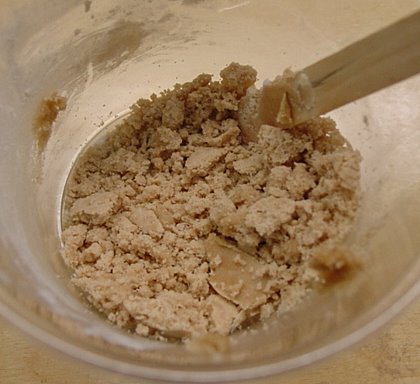
At this stage, it felt like peanut butter. The stuff could be spread like PB, but it was not sticky - not enough water yet.
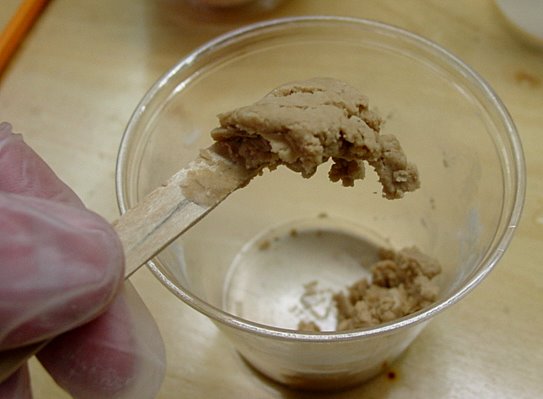
I knew from working previously with this stuff that only a tiny amount of additional water would do the trick, and for 20 grams, only two more drops of water took it to this next stage - the putty stage:
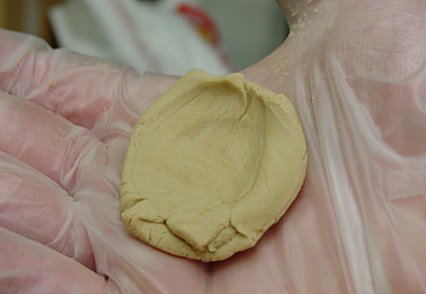
It felt, handled, and looked exactly like epoxy putty, the type you buy as a stick, and then cut. Maybe it was slightly less stiff. I continued to knead it just like epoxy putty for maybe 5 or 10 minutes. Doing this, we are both mechanically mixing, and the H2O in the putty is somewhat dissolving the crystalline material, with the desireable idea being intimate contact.
Next was granulation.

A regular stainless kitchen strainer is put to use. Have no fear of the putty at this stage - the water inhibits any combustion. I took a small lump and took a torch to it. As it dried, it burned smartly, but with the torch removed, it went out.
A small lump of the putty was placed in the bottom of the strainer, and mashed right through. None of it fell into the pan. Here's what was on the other side:
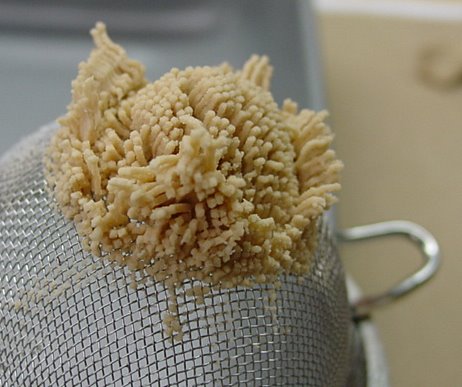
It looked like small chow mein noodles! Just like an extruded powder. I continued to press putty through, and it began to break free, still a bit clumpy, but with identifiable strands.

Under a fan, the small batch immediately began to dry nicely. I accelerated the drying of a tiny portion with a heat gun, took it outside, and WHOOSH, it was every bit as good as any KNO3 + sucrose mix I've done.
I'm going to let this dry properly, break up the noodles, screen it correctly, and bag it. I think this may be it! If it handles correctly, the next step will be comparison of this, and a batch made with the red iron oxide, which possibly was the culprit in the previous batches' bad handling properties. We'll see, but this brown noodle powder looks really nice so far.
geodkyt
April 25 2008
Looks a lot like cordite strands...
kanton
April 25 2008
Swede, this 20 gram batch of 70:30 that worked well was it the same as the sucrose and KNO3, already powdered, that you added a touch of iron oxide to earlier or some other blend?
I don't want to get confused.
Cobbler
April 25 2008
The chemical equation for the above propellant is...
9.6KNO3+C12H22O11--->4.8K2CO3+7.2CO2+11H2O+4.8N2 Someone smarter and with more time could certainly figure out the volume of gas produced in this combustion, just for the academic novelty of the knowledge. This is a ratio of 74:26... I'm assuming the difference between the "ideal" ratio and the listed ratio will produce an insignificant difference.
After seeing the latest batch and comments, something came to mind. Swede noted the paste being the consistancy of peanut butter. I wonder if it would "keep" in the putty state If so, mix up a batch and store it in a tightly sealed used peanut butter jar as a means of concealment in plain sight should the need for such behavior ever become necessary. You would probably want to use an old jar marked as organic peanut butter as that stuff usually looks and smells a bit "off" anyway
Swede
April 26 2008
Quote (kanton @ April 25 2008,16:28)
I don't want to get confused.
Yes, everything I've worked with since the successful BP recipes has been KNO3 and confectioner's sugar, plus additives. This stuff is amber rather than red because I skipped the iron oxide. I was trying to start over/keep it simple so as to lick the granulation problem. I'm still not sure the red iron oxide is necessary. The test rig will tell us.
For each batch, I decide on a ratio (say 70:30) and execute that with the two prime ingrdients. From there, I decide how much dextrin or iron oxide to add. If the batch is 100 grams, and I want 2% dextrin, I add two grams. The reason I do it this way is that I simply find it simpler than executing a 70%, 25%, 2%, 3%. Does this make sense? The KNO3 and Sugar always add to 100, THEN I weigh and add the bonus materials.
I've been doing a lot more reading, and I think sulfur will do nothing but IMPROVE this mix. I know the idea is to stay simple, but you can buy a 5lb bag of sulfur at any garden store for $6 or so. I'll do sulfuless, and sulfur batches and compare. The sulfur will do three things - it'll act as a fuel, it'll lower the ignition temperature, and importantly I think it will make the graining and handling easier.
Cobbler - Thanks buddy for the equation. I was too lazy to look it up. If we add sulfur, we'll still want 74 KNO3, but we'll drop the sugar, since sulfur is a fuel as well, so I'm thinking 74% KNO3, maybe 18% sucrose, and 8% sulfur. I think the putty would store perfectly and importantly it'd be safe. Double bagged to keep the moisture constant, and it'd last forever, I think.
When the granulation and preparation thing is licked, I'll move on to the test rig. That's where it will get interesting. Will iron oxide help? If so, how much do we use? What amount, if any, of sulfur is good? And importantly, by varying the ratios, can we change how the powder behaves relative to bore size and other things.
Overall, though, the putty method seems to be at the top as far as simplicity and effectiveness. It was easy to make, burned fiercely, and required only water and a strainer or fine screen.
Machine_smith
April 26 2008
If you have a vibratory brass tumbler you can use it to make little granules. Just dump your powder, preferably ball milled, into the tank and start the vibration motor. Get an empty bottle of windex or some such thing and fill it with water. Lightly mist (very lightly and the finest mist you can produce) the top surface of the powder. Let it run for a little while and then lightly mist again. And so on and so forth until the little balls of powder are the right size.
When you mist every droplet of water starts a little clump of powder and the vibrations keep it round and nicely packed. The trick is to mist just a little bit every so often. If you add too much water at any one time you'll end up with a sticky paste.
big art
April 26 2008
Have you tried firing any of your formulated black powder in gun yet since that is the ultimate test of any gun powder? How fast it burns openly will not tell you how it will burn in a gun under pressure. keep on experimenting... Art
Swede
April 27 2008
Art, I stuck some in a .22 case, reseated the bullet, and it fired just fine... nowhere near the velocity of smokeless but the stuff I tested was mortar and pestle green garbage. Before I do too much firing in a real weapon, I want to set up a test rig to measure velocity and hopefully some sort of crude pressure measurement, with Goex 3F being the baseline. For now the plan is .500 smoothbore with a .490 patched round ball. That should give us some good info, and should cover pistol and rifle cartridges such as .38 to .45 type stuff. As for rifle, any time you have a powder with black powder burn characteristics, you are almost always going to do best with a big bore, big capacity cartridge like a .45-70, but I've got a feeling this stuff will launch .30 cal rifle bullets at game-killing velocities.
Cobbler
April 28 2008
Swede,
I was just reviewing this thread and noticed in one of your videos it appears you had the test powder on a piece of glass If it's tempered glass, be very careful. I work with tempered glass daily. It's pretty cool stuff, tougher that you could ever imagine but when it does let go, sometimes it is rather explosive sending those little square chunks (and a whole bunch of tiny pieces) flying everywhere.
OT... how much smoke compared to BP are you getting from the KNO3/Sucrose powder?
Swede
April 28 2008
Cobbler - good observation, yes it is glass, from a mini-fridge. I was using it as a test platform because you could wash or scrape it clean. I didn't even think about breakage. Thank you. The KNO3/sugar mix smokes, not as heavily as BP, and the smell is kind of funky... a bit cleaner, sort of "chemically", and no sulfur odor. It's not unpleasant. I'd put the smoke at 60% of BP.
I have the granulation thing beaten. Persistence paid off in this case. It took about 6 tries with small batches. The secret is to produce the putty, then flatten it into a sausage patty shape. Allow it to dry a bit, a few hours, then screen. I'll put up what I'll call a "final" step by step soon.
Question - you guys ever get so involved with something, you start to lose your perspective on what the original goal was? I'm kind of in that state now. I need input. We're all relatively "handy" people here. Just how simple does this need to be?
I made a simple device, a piston ram:
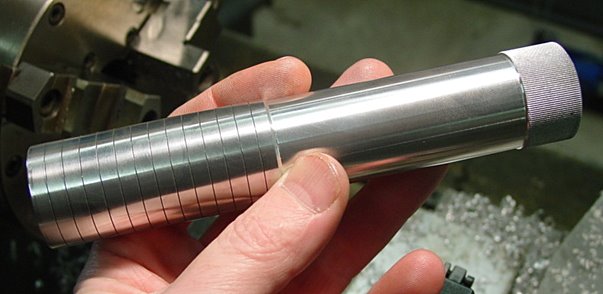
This ram fits into an aluminum cylinder with 1/8" thick walls, with a 0.002" or so fit, easy to do on a lathe. It is used to press moist powder - either BP or this putty - into much firmer disks. When processing BP, the stuff you get from the alcohol precipitation is not as dense as commercial. I'd say it has maybe 65% of the density of Goex. You can turn it into Goex, and have it screen (and perform) better by pressing the dough in a shop press. Even beating the ram with a hammer will do. Out pops a disk of powder. This puck is then screened, and beautiful, dense grains are produced. This also works with Guanidex™ and makes preparing it so much easier.
Is the goal here to be able to make emergency powder with nothing more than a bowl, a spoon, and a cheese grater? How much tooling is permitted? Truly, the performance of BP and Guanidex is predicated on good mixing and grain production. How primitive do we want this to be?
I tried a sulfur batch which was 70:20:10 KNO3, sucrose, and sulfur. It handled the best of any sucrose powder yet, and made awesome grains:
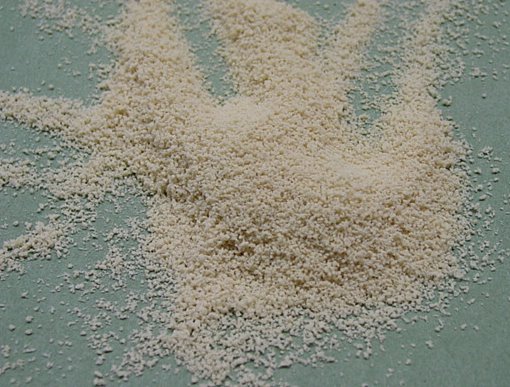
It seemed to burn the same as the normal stuff, unconfined. Further testing will show how it affects performance. It might help with ignition. But again, are we delving into the overly complicated here? Why bother with KNO3:sucrose:sulfur when BP can be made by simply swapping the sucrose with charcoal?
I'm thinking it's time to go back to basics. KNO3 + sucrose, will it work in a gun, and is it safe? The only tools allowed are hands and some sort of screen. Forget the iron oxide, unless we find that it is necessary for good performance. Thoughts? I am going to start work on a smoothbore test rig. It's time to leave the chemistry behind and start shooting stuff!
brokengun
April 28 2008
Swede; while the simpler the better might be preferred I would like to see a powder that can be used as a replacement in 30 caliber rifles with good performance.
I guess I personally got lost a few pages ago. Is the 70-20-10 batch of powder milled or hand mixed?
Swede, i was thinking over the weekend about the contributions that your making and the effect it may play in the future, all I can say is...
THANK YOU!
I was also thinking, would any of these powders be able to safely be used in a 50 caliber BMG round?
Fuzzbean
April 28 2008
My opinion is to avoid exotic ingredients or super complex procedures, but a certain amount of equipment which could be made in a small shop is OK. We are talking cells of organized resistance here, not one kook working alone in his kitchen. Not to point any fingers or anything.
Swede
April 29 2008
brokengun and everyone, thank YOU for following this far with this rambling thread. I want to be sure everyone understands that this stuff is low energy. It's going to be nowhere NEAR smokeless powder. I will be ecstatic if it can launch projectiles with enough velocity to be accurate at modest ranges. Heavier bullets will be better, I believe. If anything, it'll be a replacement for BP. I would guess if you packed a .50 BMG with it, it'd go boom, but I think the velocity will be way low. But please, no one try anything before I get a test rig set up.
It also leaves fouling behind just like BP, and it will need to be cleaned as if it was a BP gun.
This mixture is traditionally used cast as rocket fuel by HP rocket enthusiasts. There is a fine line between rocket propellants, firearm propellants, and explosives. Each has a different burning characteristic, and how it behaves under increased pressure (accelerated burn) defines its use in a gun. We've all seen movies of rockets blowing up, but most of those are liquid-fueled. Still, this stuff will blow up if confined, and that's exactly what we want it to do - in a modest and controlled way.
To summarize the alternate powder experiment so far:
KNO3 (powdered) + confectioner's sugar in a 74:26 ratio is a potent deflagrating (like that word? ) powder that will launch projectiles just like BP does. But it is very hard to turn into nice, consistent grains.
Additives - optional
Adding Dextrin (baked corn starch) up to 3% gives the grains strength.
Adding Red iron oxide up to 6% (very common, used to color concrete) is supposed to accelerate the burning, but I am not conviced yet that it does this, or is needed.
Replacing 1/3 of the sucrose with sulphur appears to make manufacture of the powder much easier. I also did some simple granulation tests with a plain kitchen cheese grater, and it seemed promising. More to follow!
Swede
April 29 2008
To test the pressure of the load, I am planning on three avenues. The first will make use of this fancy presure-sensing film:
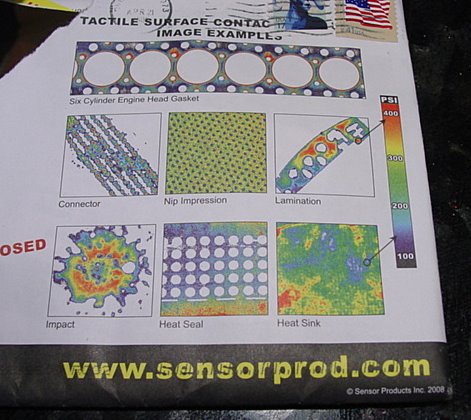
The stuff is pretty expensive, but the salesperson kindly sent me two samples. I guessed at the pressure range of 7K to 18K PSI. There is one film for even higher pressures. Inside the film are little dye-filled baloons that will color the film relative to the pressure exerted. I guess you can think of it like Litmus paper for pressure. If the pressure the piston exerts is too high or too low, and the film's range is overrun, by simply modifying the surface area of the piston's end, I can amplify it. Honestly, I can't see the pressure getting above 18K.
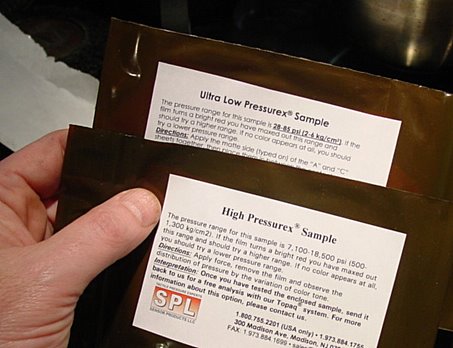
The same rig will also hopefully be equipped with Fuzzbean's solder wire deformation rig. Again, by modifying the shape of the piston's anvil, where it contacts the solder, I can amplify the force. A piston with a wedge shape like a cold chisel will definitely deform the solder wire, while an overall flat piston would have less deformation. The final method will be Gene's electronic strain gauge gadget, as outlined in the reloading section of this site. Fortunately, we really don't need to know the actual PSI, although in theory the film would allow that. As part of the sample deal, they will allow me to send the film in and have it analyzed by a computer, and it should be good to +/- 5% All we really need to do is use commercial BP as a baseline.
I am going to order some steel from Metal Express and start designing a rig.
Swede
April 29 2008
I had an interesting experience today, using my screens for the first time, as they are properly meant to be use. What I had been doing previously was simply using the screens to create grains from putty. This time, I used them to correctly sort them by size, and to do this, the grains must be completely dried, as we are no longer forcing them through the holes, but rather simply allowing gravity and agitation to do the work. I picked a coarse screen, and poured in the dried batch. Those grains that fell through the first screen were then screened by the next smaller, and so on, although in this case I stopped at three. The dextrin gives the grains strength, so once sorted, they remain at the same size.
It worked very well, although there is always a bit of loss because many individual grains are captured by the screens themselves, and end up getting washed out.
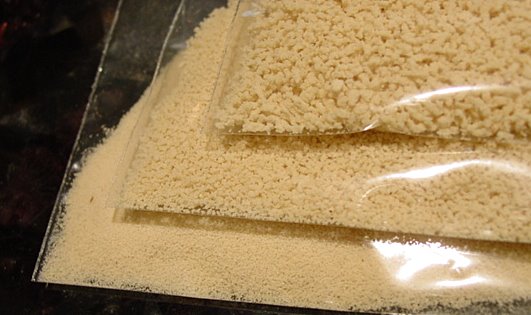
For survival or emergency use, I don't think it's this critical, but for testing purposes, I do need to be consistent between batches. The big grains in the picture look a lot larger in the photo than they are in real life. Actually they are about the same size as many extruded smokeless powders.
Cobbler
April 30 2008
What is happening chemically to the corn starch when you bake it into Dextrin?
hammermill
April 30 2008
for want of a better chemical description the heat causes the starch to break down and become a glue/paste
now somebody who paid attention in chemistery can co from here.
Swede
April 30 2008
Hahaha! I'm just a guy who never grew up with an indulgent wife who doesn't mind smoke. Two episodes come to mind.
I was newly married, and making BP, of course. I put a plate of wet BP mash in the microwave, turned it on high, and stepped away for a moment. That whole plate went WHOOOSH, probably a pound, and a wavefront of smoke was rolling up the stairs as I pounded right behind it screaming "The house is NOT on fire! Everything's OK!" She still tells the story at parties.
Swede
April 30 2008
I had so much fun with the screening tools the other day, I decided to search eBay for "sieves." Real lab sieves are expensive, about $80 on up for a larger sieve. You can certainly make sieves out of stainless, but even the loose stainless screening is not especially cheap. One thing I've found is that if you mess around much at all with powders and pyro stuff, 3 or 4 sieves in different meshes can almost be considered essential. I am going to try and figure out ways to do this without them, but a suggestion - if you ever feel like you want to get serious with making BP, snag a couple of the surplus lab sieves off eBay at 15% cost, and they will repay you many times over. The good ones are stainless, and you can simply turn the hose on them outside to clean them. The ones I made have wooden frames, and even with good polyurethane finish, I have to be careful of water damage.
Just a head's up! Once again, eBay comes through, despite their anti-gun leanings.
hammermill
April 30 2008
i wonder how the baking sieves will work so tomorrow i will call a dealer in used bakery equipment and see what he has.
fa 20\64 2fa num4 3fa num10 4fa num12 5fa num20 6 fa num30 7 fa num40 someone have a chart for 1thru 6f sporting
Swede
May 01 2008
Hammermill - from a sieve maker, I found this chart - The basic mesh sizes I bought as bare wire from Skylighter are 10, 20, 40, 60, and 100 mesh. The most useful for this project are the 10 through 40. The 100 mesh is really fine. I cannot imagine something as fine as 635 mesh. It would be REALLY fine.
I did quite a bit of searching online. If you don't want to go to the trouble of messing with eBay, your choices are make your own, buy expensive sieves, or search for alternatives. Here's some inexpensive sieves used by pottery people. They look pretty good. Yet another bunch of sieves, as used by the pottery people. I'd go with these because with homemade powder production, we are not conducting high-grade research, just making powder. The bulk of the test sieves out there are extremely precise and have a high cost as a result.
I'm guessing a µm = one one-thousandth of a mm. Here's a link to an excellent chart.
No. 8 2.36 mm
No. 10 2.00 mm
No. 12 1.70 mm
No. 14 1.40 mm
No. 16 1.18 mm
No. 18 1.00 mm
No. 20 850 µm
No. 25 710 µm
No. 30 600 µm
No. 35 500 µm
No. 40 425 µm
No. 45 355 µm
No. 50 300 µm
No. 60 250 µm
No. 70 212 µm
No. 80 180 µm
No. 100 150 µm
No. 120 125 µm
No. 140 106 µm
No. 170 90 µm
No. 200 75 µm
No. 230 63 µm
No. 270 53 µm
No. 325 45 µm
No. 400 38 µm
No. 450 32 µm
No. 500 25 µm
No. 635 20 µm
brokengun
May 01 2008
Swede; After reading your last post it caused me to remember a recipe for gun powder. The recipe called for the mixture to be screened using a 100 mesh screen.
The recipe used potassium nitrate and sugar. I also remember something about needing the small grain size to increase burn rate.
Swede
May 09 2008
I just wanted to let you guys know that this project is still underway. I have some parts on order to make the test rig, and if everything works well, I hope to do one final photo-installment, from beginning to end, turning stump remover and sugar into useable gunpowder.
On the primer-side of things, I think I have found a primer recipe, but I need to say that primer compounds are DANGEROUS and there is not a single one that I am aware of, other than strike-anywhere match heads (which I will not touch) that does not use some moderately exotic chemicals. The one that I am going to attempt makes use of Potassium ferricyanide and acetylene gas, among others!
Primers need to be made in very small batches, just a few grams max. Anyway, this project is still in progress.
coyote65
May 09 2008
For those wanting to emulate Swede, Harbor Freight has 2 different electronic scales on sale now. One that weighs up to 17.64 ounces for 12.99, and one that weighs up to 11 lbs. 19.99. 93543, 95364. Maybe if purchased off HF will keep the feds off your back.
Swede
May 14 2008
While I wait for components for the test rig, I continued to mess around a bit with processing homemade BP. The last batch I made was a small 300 gram sample, but it was made with true willow charcoal, and not the mixed hardwoods I had been using. I expect it to be very fast.
As I've found, making the BP is easy; it is the granulation that can be tricky. If you have a ball mill, you literally load the jar just like you'd load one of those automatic bread machines - just toss the stuff in there. The charcoal can be in big chunks. The KNO3 can be prilled. The ball mill just beats the tar out of everything, and you end up with excellent BP like corn starch.
But the super-fine mill powder is REALLY light and messy. Spooning it into a bag causes the dust to fly, which can be dangerous. Plus, as it is, it is too fine to be used for just about anything.
Earlier, I turned the dust into dough, which can be screened with a window screen to a very useable powder. The problem with that powder is that it is nowhere near as dense as Goex. If I filled up a cartridge case with Goex, then weighed it, it might weigh 50 grains. The exact same volume of doughed and screened powder might weigh only 34 grains! It is about 2/3 as dense. This has big implications...
If you are replicating an old load like .45-70, you will find you can't get the 70 grains in there without crushing the powder, and that will change the burn. Also, more mass in a given volume = more energy, so we want our homemade powder to weigh and measure just like Goex. There is a home shop way to do this, and that is with a press.
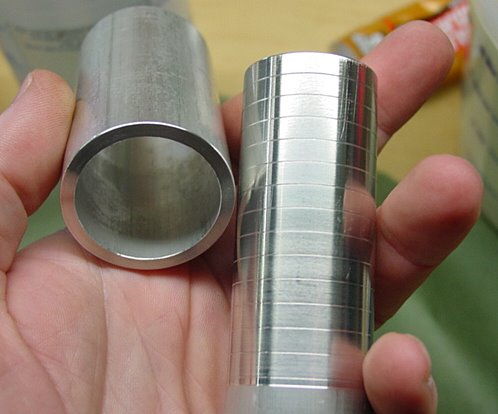
I used the ram I made earlier. This guy is a little small, but smaller is often better when it comes to pressing. The overall process is called corning, and what we are doing is consolidating the mill flour into dense, solid masses, which are then broken up and screened.
As part of the mill process, we introduce a binder, either red gum, or dextrin, about 3% works fine. The binder goes right in along with the other raw ingredients, and is consolidated with the BP during milling.
Swede
May 14 2008
To begin the corning process, we wet the mill powder VERY slightly. If you are using red gum as a binder, use a 50/50 mix of water and alcohol. Distilled booze would work in a pinch. If you used dextrin, probably more likely since it can be made from corn starch, you use 75/25 water/alcohol, or hard booze slightly watered.
Weigh the mill powder. If the powder weighs 100 grams, add 10 to 12 grams of liquid. Stir for a few minutes with a wooden stick. You won't notice much change other than some clumping - there's not enough liquid to do too much. You then spoon your moistened powder into your ram. The ram can be anything, aluminum, PVC, brass, but I'd stick with a non-sparking material.
Place the ram on a flat surface. I used acrylic. You must now apply serious pressure. Most people have a vise, and you can put the vise to work to do this. A hydraulic press is best, and you can make a homemade press if need be from a car jack bottle. The last option is a mallet, but it doesn't work nearly as well as the other two.
What pops out after pressing is a disk that looks exactly like the brush material in an electric motor, a hard, shiny almost ceramic-like disk. The powder is now consolidated and ready to be corned.
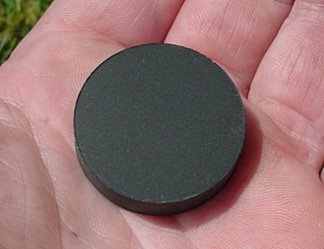
You want to keep the disk relatively thin, Too thick, and the pressing is not as effective.
This disk is pretty small, because my ram is small. Most corned disks will measure 2.5" or so diameter by 1" or so thick.
You now have the option of waiting until it dries (I'd go a day or two) or you can force the drying (be careful!) with a heat lamp. The disks should never be too hot to handle. If you cannot comfortably hold them, then they are way too hot. You should be able to pinch them firmly between your fingers, and the effect should be, "They're nice and warm" but it shouldn't even come close to discomfort. Best would be to dry naturally in the sun. Being black, they soak up the sun's rays and this works well.
The next step is the most dangerous part of the process. In a safe area, take a disk and crack it to pieces with a plastic mallet. Beat it into fragments. Some of it will be dust, much will be really granular (you can beat these down further), much will be 3F and 2F size.
Crack one disk at a time in a separate area from the other disks, and the stuff you've cracked earlier. ONE AT A TIME.
Consolidate all the granules, and screen them. This is a different screening... we are not forcing the grains through, just gently allowing the screens to sort by size. You can certainly help with the larger grains by pressing with your thumb a bit, but generally let gravity and vibration do the sorting.
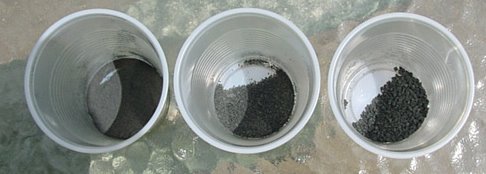
This is the result of 3 screens, 10, 20, and 40 mesh. The stuff on the right is like cannon powder. The stuff in the middle looks to be close to 2F or 3F. The powder to the left is everything else. It can be used in small calibers, as priming powder, OR it can be saved and re-pressed in the next batch.
Swede
May 14 2008
BC, the ram is aluminum. It is safe to use, as is one of brass or plastic. The powder is moist, and is pretty stubborn about burning, even when lighted with a match. The pressing process really isn't too dangerous, it is the cracking of the disks that can be a bit riskier. Still, the more I've worked with BP in this project, the more comfortable I've become. That sounds bad, and it can lead to complacency, but I guess what I'm trying badly to say is I've done a TON of research on BP as used both in fireworks and firearms, and the process I'm describing is done exactly this way by the professionals. They use an incredible amount of BP to build those big shells, and they don't buy Goex, they make their own. Accidents in making BP happen much, much less often than people think, and most accidents come not from BP but from other materials.
Still, being meticulous, wearing a face shield, working with small quantities at a time, all important stuff.
page 27
Swede
May 14 2008
A quick summary so far of home BP production...
1) Green (mortar and pestle) BP simply sucks. It can be made to work, but if you don't have a ball mill, do option 2.
2) The "CIA Method" using water and alcohol, as desribed at the beginning of this thread. Turn the CIA dough ball into grains with a window screen. You now have good BP that will work well in any firearm.
3) A ball mill. I can't say enough good things about ball milling. Here's a perfectly acceptable "ball mill" from Harbor Freight:
HF Rock Tumbler, 30 bucks
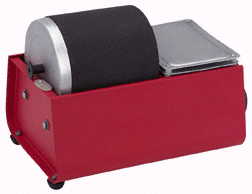
With this cheap rock tumbler, you can make a half-pound or more of BP in 4 hours. They have a 2-drum tumbler, too. For media, take a 1/2" brass round stock, and cut it into 1/2" long nuggets, enough to fill the drum halfway. Add enough raw ingredients to fill the drum 2/3. Seal, and mill. Easy! The HF drive belt is a POS though so buy spares, make your own, or use a big rubber o-ring.
With the mill flour you then have these two options:
A) Moisten to a dough-ball with alcohol and water; screen, dry, go BOOM in your favorite weapon; or,
B) Press the mill flour, partially dry the disks, crack the disks, screen. If you started with softwood charcoal like willow, pine, balsa, you now have Goex... or BETTER than Goex, as they use mixed hardwood charcoal.
Oh yes, as part of the summary, I want to mention sieves and screening. You can use aluminum window screen in a pinch, but much, much better are these "glaze sieves" from the pottery people... Google "Glaze Sieves" for many hits.
And here's a guy that sells bucket sieves to pyro people:
I wasted money on screens that are too fine. The ones you want for guns are 10, 20, 30, 40, and 60 mesh. If you want to go with a short set, get the 20, 30, and 40. The mesh size to make that nice 2F stuff was a 20.
Swede
Aug. 03 2008
Thank you! The pressure rig is still on the horizon. I have all the parts, just need to get it done. The problem, I can't get ANYTHING done right now due to the heat. I moved about three years ago into an airpark home. I've got a 40' X 50' hangar/workshop right out back. I thought it'd be my dream shop. But if it's 105 degrees outside with high humidity, the shop is 120 degrees. I'm serious, I measured it!
I've got one of those 5' diameter industrial air movers. The air it blows is HOT. I've tried everything to cool that place down, no luck. So for about 3 months out of the year, it is unbearable out there. I've got to do something about it this fall, put up a wall or partition, get some sort of climate control going.
I'm still messing with alternate (ghetto) powders for apocalyptic scenarios. It is possible to make good guncotton with hardware-store ingredients... I've got a simple extruder, which can turn gelled guncotton into strands, like they used to do it in the old days. It would be nice to come up with a genuine single-base smokeless that has none of the faults of the original products, namely excess temperatures and barrel erosion. A test rig would help with that project as well.
This is a tricky, sticky issue, because the world is full of nutjobs whose goal is a bomb, and propellants can be turned into bombs by confining them. But propellant research has applications outside of illegal bombs, and frankly, from the research I've done these last few months, if you want a much simpler bomb recipe than either BP or nitrocellulose, it will take less than 1 hour of googling to come up with some very, very dangerous compounds. I like firearms, model rockets, and safe/sane pyrotechnics and fireworks, NOT "kewl Bomzz doods!"
nowhereman
Aug. 03 2008
Swede, have you considered making brown powder? The sulfur content is 2--3% and the charcoal is made from straw. Attached is an article in .pdf from The New York Times that gives technical details.
Swede
Aug. 04 2008
I have heard of brown powder before, that is a good article. IIRC brown powder was engineered mainly for huge cannon. In the late 1800's, warships were looking to launch 12 and 14" projectiles, and the burn of the powder needed to be a gentler, more progressive push rather than a sharp bang. Brown powder got a lot of its energy from the partially carbonized straw. They didn't char it as much as they normally would, and this altered the pressure of the burn, and I believe gave it a bit more energy per pound.
That was a very interesting time for propellants. Smokeless was coming, black powder had been perfected for hundreds of years, and inventors were going nuts with alternate propellants using mixtures of nitroglycerin, salts, stuff like that.
I'm still amazed at the earlier article that said the U.S. government had tested guncotton (nitrocellulose) powder waay back in the civil war. It blew up the springfield rifles, and rather than recognize the huge energy content of the powder and improve the rifle with better metallurgy, they blamed the powder and called it unsuitable.
geodkyt
Aug. 04 2008
Well, the Army was looking at guncotton as a replacement for powder for existing weapons -- they had no funding to conduct a wholescale rearmament -- so if it didn't work in the existing guns, it was (at the time) useless to them.
nowhereman
June 04 2009
Swede, if you are still interested in completing the research, the following website has a compound that will allow you to measure the relative maximum stress relatively simply. In other words, prepare a barrel and fire it with commercial black powder, take a picture of the cracking, then fire it with the saltpeter—sugar powder, take another picture, and compare the two. The website is: http://www.stresskote.com/ . The patent number is: 2428559.
Kenny_McCormic
June 19 2009
How about using paper or cardboard from a recycling center for making charcoal? That should be softwood but I dunno what the glue would do.
Swede, go underground(blast a big hole with all that powder you made), or try to come up with some sort of swamp cooler or geothermal setup(put that big fan to use).
<>Fulmen
June 20 2009
Quote (Swede @ Aug. 04 2008,10:23)
I'm still amazed at the earlier article that said the U.S. government had
tested guncotton (nitrocellulose) powder waay back in the civil war. It blew
up the springfield rifles, and rather than recognize the huge energy content
of the powder and improve the rifle with better metallurgy, they blamed the
powder and called it unsuitable.
It's not as simple as that, for a long time NC was pretty useless as a propellant. Not only is it inherently unstable, it also burns extremely hot and fast. It wasn't a matter of just beefing up the guns, NC just isn't suitable as a propellant in it's raw fibrous state.
The first NC-powders were "bulk powders" which was basically partly nitrated sawdust impregnated with nitrates, and while it was still too fast for rifles it worked fine in shotguns.
The first really successful NC-powder was the french Poudre B (1884), and the power and potential of this powder did not go unnoticed. The solution was to treat the NC with solvents allowing it to be shaped as a dense solid (colloided powders). The stability was still an issue though, IIRC the french lost a couple of battle ships due to spontaneous ignition.
geodkyt
June 22 2009
Still, when the goal is to convert stocks of EXISTING weapons, any propellant -- regardless of how well it works in weapons built for it -- is "unsuitable" if the guns they are trying to use it in won't take it.
If you were loading for an old turn of the 20th century Damascus barreled shotgun, modern shotshells are, by and large, "unsuitable" for your gun, even if they will fit just fine. Standard USGI ball powder in 1964 was "unsuitable" for the AR15, even though it worked just fine in WWII era weapons.
Fulmen
June 22 2009
True enough, but you're talking of fairly minor adjustments to ensure proper performance. Once the main difficulties with NC-powders were solved they were quickly adapted to use in exiting guns, albeit with reduced performance compared to it's potential. Before the development of colloided powders the only thing NC could be used for was as an explosive. And even there they had major problems as the dry powders were extremely flammable and prone to spontaneous ignition.
I can easily understand how someone could abandon NC as a viable propellant in those days. Don't forget that both chemistry and physics were fairly infantile sciences compared to what we know today.
mike_au
June 22 2009
Quote (Kenny_McCormic @ June 19 2009,23:55)
How about using paper or cardboard from a recycling center for making
charcoal? That should be softwood but I dunno what the glue would do.
Some people have had good experiences with newspaper charcoal.
I believe the biggest problem is repeatability, if you use timber from a certain tree or at least species of tree you can go back and produce another batch with similar performance without too much trouble.
When you use paper/cardboard/etc you have no idea how the content (and therefore the performance of the finished powder) will vary from batch to batch.
Good timber for charcoal isn't too hard to find in most areas, willow is generally concidered the standard but there are dozens of other species that are almost as good (or in some cases better).
In the long term I think you are better off doing some experimenting until you find a good source of wood.
williboy
June 22 2009
I had the best luck (fastest powder for cannon and rockets) using grass (yard clippings) charcoal. Same preparation as for hardwood charcoals, a lot of volume reduction, and relatively easy to make for me than most others.
I obtained very repeatable results, but I was using the same yard all of the time as a source.
Fuzzbean
June 22 2009
Good timber for charcoal isn't too hard to find in most areas, willow is generally concidered the standard but there are dozens of other species that are almost as good (or in some cases better).
I'd like more details on this. I got lots of tag alder and poplar...
mike_au
June 23 2009
Quote (Fuzzbean @ June 23 2009,08:36)
I'd like more details on this. I got lots of tag alder and poplar...
Have a look at:
http://www.pyroguide.com/index.php?title=Charcoal_Suitability_Table
and
http://www.wichitabuggywhip.com/fireworks/charcoal_tests.html
Both are more about pyrotechnics than firearms, but I would imagine that the requirements would be fairly similar.
It looks like both alder and poplar might be pretty good performers.
geodkyt
June 23 2009
Quote (williboy @ June 22 2009,22:31)
grass (yard clippings)
Nice. "Cause the grass has gotta be cut anyway, and unless you use a mulching mower, it's a PITA to compost.
(Of course, as fast as my unwatered, unfertilized, unpampered, lawn grows all summer, even with weekly cuttings and a mulching mower, I end up with rows of "hay" I've got to go back and clean up.
williboy
June 23 2009
I disagree with that first link above that grass is unsuitable for bp. I had great success using grass clipping (a mix of grass, weeds, and probably manure) for charcoal. I raked clippings a day or 2 after mowing that had already browned and were crunchy, and cooked in a metal container just like you would for a hardwood charcoal. The part I liked most about the grass charcoal was that you do not have to crush or mill it after cooking to be able to use it. I would screen it to be sure any twigs, stones, etc. were out, and bag it up before going to the scales.
I processed my bp in 8-16oz mill jars, ran a standard 75/15/10 mix, and ball milled it all together, dry, for 4 hours. I would screen the green bp, and use that for priming, or with a little modification for rockets. For lift/cannon use, I would wet press to 1.65-1.7g/cm3 and corn out after drying.
I had NEVER made a bp suitable for shell breaks until I started to use grass charcoal. I had rockets that had never cato'd until I started to use grass charcoal, and I had never had as hard of flakes after corning until I started to use grass charcoal. For me, grass made a fantastic charcoal!
I believe it was the Dan William's Pyro site that first led me to play with grass clippings, but I am not positive. Dan's site is unfortunately gone from the web, but I do have a pdf of it from towards the end. It has been years since I have dabbled in the amateur rocketry hobby. Life has limited that opportunity of late. HOpe this helps.
mike_au
June 23 2009
Grass is probably one of those things where there are hundreds of different species. Generalizing and saying "grass" is good or bad probably doesn't mean much, you happen to have a good one, whoever wrote the list happened to have a bad one.
I vaguely recall reading something a while ago about BP made with a certain charcoal being incredibly sensitive to ignition from friction, I think it may have been some type of straw or hay. It might be worth doing some tests if you use grass just to make sure you don't get a similar effect.
geodkyt
June 24 2009
Some of the biggest factors in charcoal quality are the temperature it's produced at, the density of the stock material, and the level of impurities in the stock material.
cobbler
July 16 2009
Quote (mike_au @ June 23 2009,21:50)
I vaguely recall reading something a while ago about BP made with a certain
charcoal being incredibly sensitive to ignition from friction
One of the reasons that bp made from some types of grasses could be that those grasses may have a lot of silica (same material as sand but much smaller particle) in them. It might be a friction agent the same way powdered glass does in caps.
brokengun
July 17 2009
I remember reading how the defenders of Atlanta used a charcoal in their BP made from human hair.
Anyone ever hear of this recipe for bp using human hair?
P.S. What's the optimum temperature for making charcoal?
I have family that lived in Boston at the time of the revolutionary war and had a blacksmiths shop.
Like many anti-federalist disgruntled at the thought of a federalist government they moved to Illinois which was the furthest western territory at the time.
When they got to Illinois they started another blacksmith shop.
That side of the family has been running blacksmith shops and now country machine shops ever since.
The grandfather of the current family machine shop operator used to make his own charcoal for his forge and sadly everyone is either dead or too young to remember how it was done.
The only thing that they can remember is his cooker (that's what he called it) was made out of bricks and it was large enough for grand dad to get into but that's about it.
Can anyone shed some light on how it was done?
solarguy
July 21 2009
In the stripped down version, charcoal is just wood (or other carbon rich substance, grass, bones and hair among other things apparently) which are heated to temperatures that would cause them to ignite and burn, but in the (more or less) absence of oxygen. There are a bunch of variations, here's two basic ones:
1. Start with a steel container like a 55 gal drum with a clamp on lid (no rubber gaskets...) and some strategic holes to control draft so it can be made airtight, or very close to it. Pack it full of wood (or your fave starter product) and light on fire with the draft control pretty much wide open. When the fire get going "good", clamp down the draft control until you achieve a very slow smoldering fire, just barely. Let it run that way for a "while". Then seal it completely and wait for it to cool off. A google search for "how to make charcoal" will get you a jillion recipes.
2. Instead of using the fuel in the container to cook/burn/heat itself, you just 99% seal the container full of starter product. Don't seal it entirely, as making charcoal is essentially driving off the volatiles we don't want. That gas has to vent somewhere. Then you heat your container with a separate fire on the outside for "a while", etc.
Traditional colliers don't use pyrometers, and it would take a lot of work to build an oven you could control well enough that even measuring the temperature would be worthwhile. Primitive "coal" makers get the heap burning and then pile dirt and/or sod over it to control the burning down to slow smoldering. It takes a whole day and you will be filthy and stinky when you're done. A nicely stacked pile of heat resistant bricks could make a good oven.
Pick a recipe. Try it. Repeat as needed. It's more like learning to ride a bicycle than baking a cake though.
Murph
Dec. 07 2011
Swede, a lot of the amateur rocket hobbyists said to hell with KNO3/sugar, as the damn stuff was too sensitive to moisture in the air and was a SOB to work with.
This website has some very interesting propellant mixtures, and much easier to work with, too, IMO.
And as to the use of ascorbic acid/KNO3/Fe2O3 as a propellant, here's an excellent mixture, and well tested and documented as well:
theoldsarge
Dec. 07 2011
Say, that reminds me. Haven't seen any posts by Swede since early in this year. Anyone know if he's OK or not?
mike_au
Dec. 08 2011
He has disappeared from the pyro scene as well.
I know a few people tried to email but couldn't reach him.
DoctorX
July 22 2012
Has anyone heard from Swede? Is he still around?
Kenny_McCormic
Feb. 10 2013
I may have developed a new method of making BP fast and easy, using a sort of wet milling technique in a household blender. No ball mill, no heat. I would like to start by saying that this experiment was done on a 50 ft extension cord, in an old 2 drawer filing cabinet minus the top drawer, with a piece of 1.5" fiberboard leaned on the back for additional blast shielding. The cabinet was aimed away from anything of value. In other words, this is probably not very safe.
I simply poured 150 grams of stump remover, 30 grams of pea sized mixed charcoal taken from the woodstove's ash bucket and mashed up, 20 grams of dusting sulfur, and around 6 grams of home made dextrin into the blender, then added 91% isopropyl alcohol to cover it, 99% or denatured ethanol would be better. Then the blender was set up in the cabinet, I believe I set it on a medium setting, and plugged in remotely. I then ran the blender 5 minutes, shut it down and checked, things were mixing up nicely, and it was getting slightly warm and cooking off some of the alcohol through the loose fitting cap. I ran it another 5 minutes on medium, then checked again, now it was starting to get homogeneous, most of the charcoal was ground up, and you could see the little bits of KNO3 not yet ground in. The idea being that the alcohol will stabilize the powder, without dissolving the KNO3 that the blades are mashing into the charcoal.
At this point the mix was thickening up to a point where the blender couldnt mix it, so more alcohol was added and the blender cranked up to full power. I continued running it 5-10 minutes and then going in to add more alcohol, each time noting that the mixture was getting more and more smooth, the KNO3 was being ground up into the charcoal. Eventually I was satisfied and poured/scraped the thick mix out onto a cookie sheet to dry.
The mix dried up and cracked itself into easily handled chunks, while still moist I ground this through a window screen into a disposable turkey roasting pan and let it dry. Some of the wet stuff spattered on the cookie sheet during pouring and was already dryish, probably 15 grains or so, I scraped this off into a pile and lit it with a kitchen match, I'm missing some hair on my hand from the flash. The dry finished product powder burns fast, almost with a "whoomp" noise. Its pretty coarse, on the heavy end of 2F powder, and burns faster than "3F" pyrodex P with around the same residue. Yield around 85%, but I didn't scrape the blender out very well. I dont have any commercial to compare this with, but I think that at $20+ a lb for commercial stuff, and some better corning techniques, you could produce decent powder this way a pound at a time. In about an hour ignoring drying time.
I haven't had time to test some of this in a gun yet, but expect it to perform good enough for plinking.
brokengun
Feb. 15 2013
Kenny, what's homemade dextrin?
Kenny_McCormic
Feb. 16 2013
Dextrin can be produced by baking corn starch in an oven at 350*-400* for hours till it turns a light tan-golden brown color. Its a binder to give the grains strength.
Some more info on this batch of wet blended powder. Its somewhere in the range of 1/2 to 2/3 as dense as the real deal. The finished product came out a bit course than intended, with a lot of short strings and small clumps. While it sounded about right in my single shot .45 caplock pistol, it produced poor velocity compared to pyrdodex P by volume, the (IIRC 200grain) Lee cast bullets with ~30 grain charges (3 9mm case fulls) were merely denting the sheet of particle board I was using for a blast shield earlier, pyrodex would blow a hole through it with a fist sized exit. I'm going to load some shotshells where the coarse power will have some time to burn and see how it does there. Judging by how the crap scraped out of the drying pan burned, I think my trouble is all in the corning.